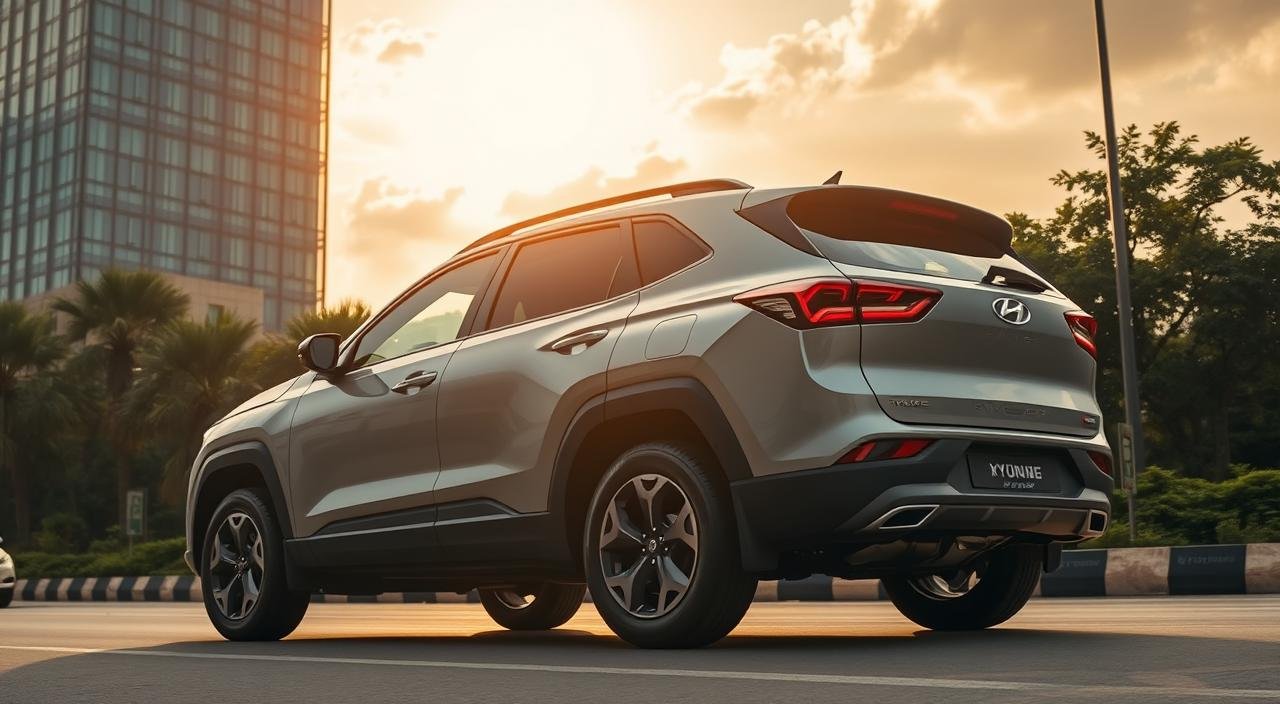
Oct
Last month, over 200,000 compact SUVs were sold in India. This shows how fast this market is growing. The 2025 Hyundai Venue is a big step for Hyundai to get a bigger piece of this market.
The new Venue has shed its camouflage for India. It takes design cues from the Exter, Creta, and Alcazar. Hyundai is introducing eight different versions, from HX 2 to HX 10.
Now, you can book the Venue for Rs 25,000 at Hyundai dealerships or online. It will come with both petrol and diesel engines on November 4, 2025. Prices are expected to start around Rs 8 lakh ex-showroom.
The 2025 Hyundai Venue marks a big change in Hyundai’s SUV plans. It shows off new looks and better comfort inside. Hyundai hopes it will beat out the Maruti Suzuki Brezza and Tata Nexon.
Key Takeaways
- Second-generation Venue officially unveiled for Indian market with design cues from Exter, Creta, and Alcazar
- Eight variant lines available: HX 2 through HX 10 with both petrol and diesel engine options
- Bookings open at Rs 25,000 through dealerships and online platforms
- Official launch scheduled for November 4, 2025
- Expected starting price around Rs 8 lakh ex-showroom
- Hyundai Venue updates 2025 India target the growing compact SUV segment
Overview of the 2025 Hyundai Venue
The compact SUV market in India is getting a boost with the 2025 Hyundai Venue. This updated model offers new design and tech features. It aims to be a top choice in the sub-compact SUV market.
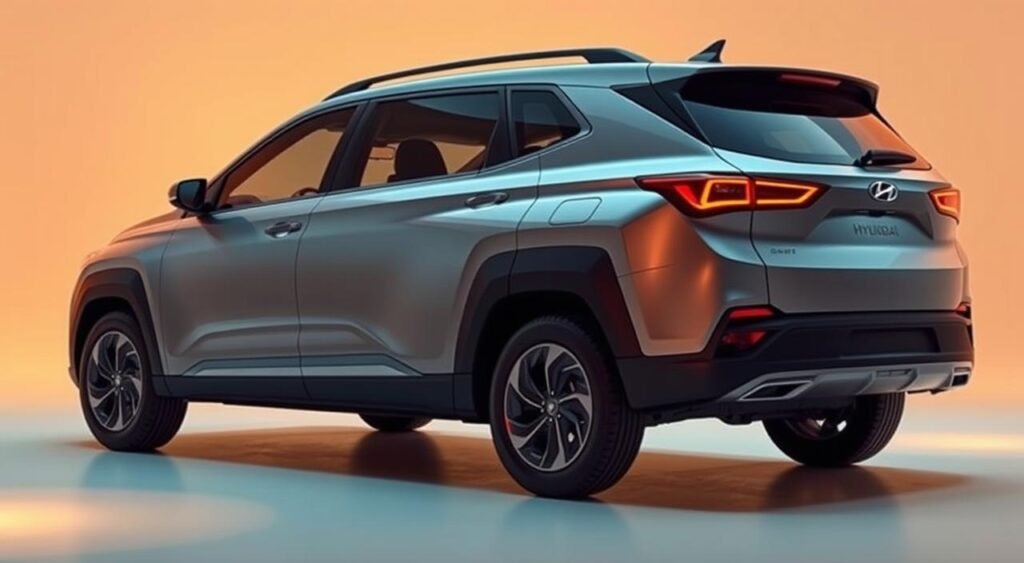
Design Philosophy Update
The 2025 Venue has a new look that fits with Hyundai’s SUV lineup. Its front has a split-headlight design with LED lights. This makes it stand out on the road.
The design is both bold and elegant. It’s perfect for city drivers who want style and quality.
Key Features Overview
The new Venue is packed with tech. It has two big screens for info and entertainment. The seats are ventilated for comfort, even in hot weather.
The Bose sound system adds to the luxury. It makes music sound like a concert in your car.
| Feature Category | Specifications |
|---|---|
| Display System | Dual 12.3-inch screens |
| Audio Setup | 8-speaker Bose system |
| Seating Comfort | Ventilated front seats (3 levels) |
| Driver Convenience | 4-way power adjustment |
| Safety Features | 6 airbags, Level-2 ADAS |
| Sunroof Type | Single-pane electric |
It also has white ambient lighting, automatic climate control, and wireless charging. Safety is a big deal with six airbags, a 360-degree camera, and more.
Exterior Changes Worth Noting
The 2025 Hyundai Venue has a fresh look with new exterior updates. Spy shots and Hyundai Venue news updates show big changes in colors and lights. These updates make the compact SUV look modern but keep its urban vibe.
New Color Options
There are six monotone shades to pick from in the updated lineup. The Hyundai Venue India launch 2025 adds two new colors: Hazel Blue and Mystic Sapphire. These join favorites like Dragon Red, Abyss Black, Atlas White, and Titan Grey.
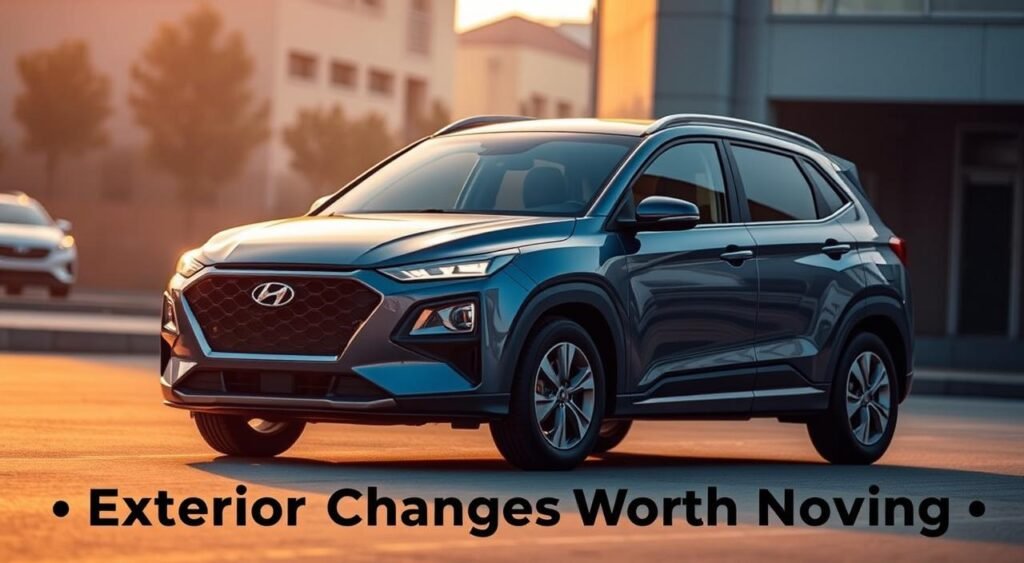
Dual-tone fans have two options: an Abyss Black roof with Hazel Blue or Atlas White body. These options start from the HX 6 variant and up. The HX 2 and HX 4 trims have fewer colors to keep prices down.
Upgraded Lighting Elements
The lighting system gets a big update for the Hyundai Venue India launch 2025. LED daytime running lights now have a unique C-shaped pattern. They frame the rectangular grille with subtle chrome accents.
Quad-LED projector headlights are below the DRLs for better night vision. The rear has wraparound LED tail lights with three-piece internal lighting. The front camera is in the grille for the 360-degree view system. Side mirrors now have cameras underneath, a first for the Venue.
Interior Enhancements
The Hyundai Venue 2025’s interior has seen a major upgrade. It now features a dual-tone color scheme of Dark Navy Blue and Dove Grey. The premium leatherette seats make the cabin feel luxurious, setting a new benchmark for compact SUVs.
Redesigned Cabin Space
The dashboard now has a layered minimalistic approach that looks more upscale. It has vertical side AC vents and sleek central vents, all with light bronze accents. The Venue branding is beautifully placed on the co-driver side, adding a personal touch.

The center console is both practical and organized. It has two cup holders and a gear shifter, along with buttons for seat ventilation and electronic parking brake. A rotary dial makes it easy to switch drive and traction modes while driving.
Advanced Infotainment System
Technology is at the forefront with curved 12.3-inch dual displays above the air vents. One screen is for infotainment, and the other is for digital instrumentation. This setup rivals premium vehicles in higher price ranges.
The steering wheel has a new three-spoke design. Instead of the usual Hyundai logo, it has Morse code styling with four dots for ‘H’. This unique feature shows Hyundai’s attention to detail, something buyers will love during the India debut of the 2025 Hyundai Venue.
Performance Improvements
The 2025 Hyundai Venue offers exciting engine choices for Indian buyers. It has three engine options for different needs and budgets. Each engine balances power and fuel efficiency, making the SUV versatile.
Engine Options Available
The base engine is a 1.2-liter naturally aspirated petrol engine with 83 PS and 114 Nm torque. It comes with a 5-speed manual transmission for those on a budget. The mid-tier engine is a 1.0-liter turbo-petrol engine with 120 PS and 172 Nm torque. It can be paired with a 6-speed manual or 7-speed dual-clutch automatic.
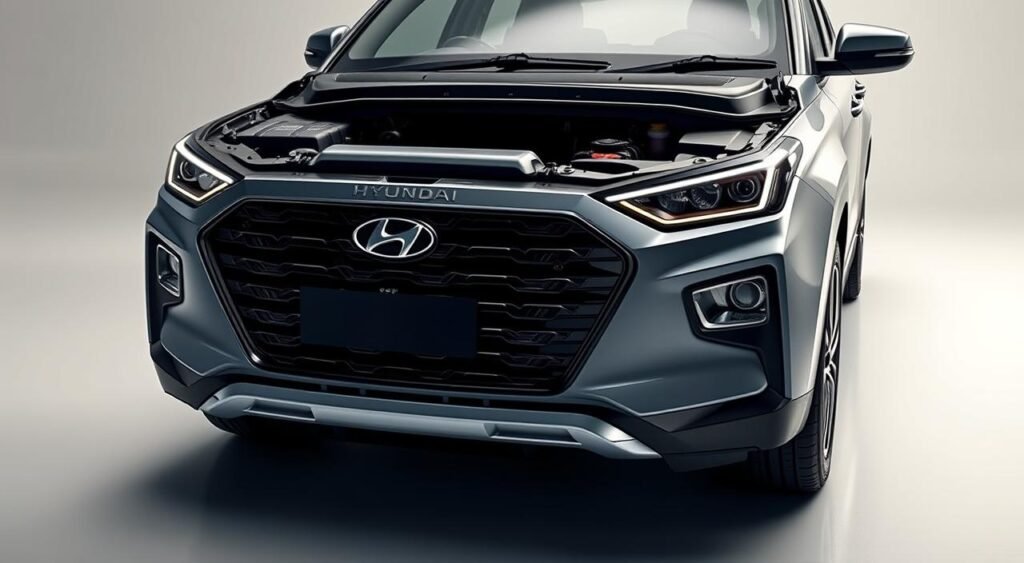
The diesel lineup includes a 1.5-liter engine with 116 PS and 250 Nm torque. It offers flexibility with 6-speed manual and 6-speed torque converter automatic options. The diesel-automatic combo is a key update, inspired by the Kia Sonet.
Fuel Efficiency Ratings
Fuel economy varies by engine. The naturally aspirated petrol gets about 17-18 km/l in mixed driving. The turbo-petrol gets 18-20 km/l with manual transmission. Diesel engines lead with 23-24 km/l for manual versions.
Automatic transmissions lower these figures by 1-2 km/l for all engines.
Safety Features Upgraded
The 2025 Hyundai Venue in India has major safety upgrades. It leads the compact SUV market with these changes. It has Level-2 ADAS technology with a radar sensor and a camera.
These systems offer top-notch protection for everyone inside and outside the car.
New Driver Assistance Technologies
The Hyundai Venue 2025 comes with many driver help features. It has a 360-degree camera system for better visibility when parking. This system includes cameras in the front and side mirrors.
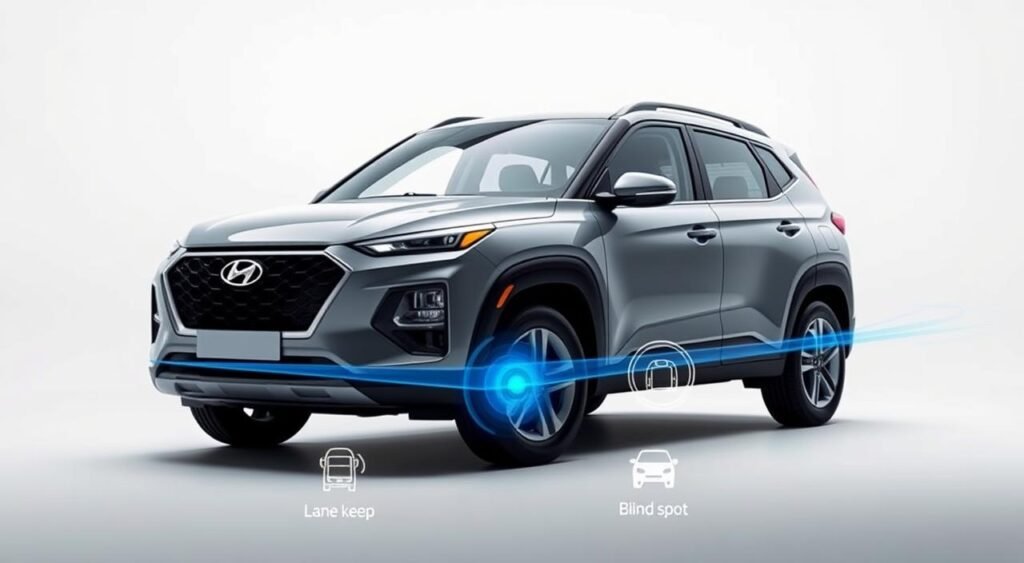
- Electronic Stability Control for improved handling
- Front and rear parking sensors
- Electronic parking brake with auto hold function
- Tire pressure monitoring system
- ISOFIX child seat anchorages
Crash Test Ratings Expectations
Experts think the 2025 Hyundai Venue will do well in crash tests. It has six airbags in every version. This shows Hyundai’s dedication to keeping people safe.
| Safety Feature | Standard Trim | Premium Trim |
|---|---|---|
| Front Airbags | 2 | 2 |
| Side Airbags | 2 | 2 |
| Curtain Airbags | 2 | 2 |
| ADAS Level | Level-2 | Level-2 |
Technology Innovations
The 2025 Hyundai Venue introduces advanced technology to the compact SUV market. It brings smart integration and digital sophistication to the driving experience. The cabin features state-of-the-art systems, rivaling those in more expensive vehicles.
Connectivity Features
Modern drivers want easy connectivity, and the latest Hyundai Venue updates deliver. The vehicle now includes:
- Wireless phone charging pad for compatible devices
- Premium Bose audio system with eight speakers
- Multiple USB ports for device connectivity
- Bluetooth integration with voice commands
The Bose sound system offers clear audio, making every drive enjoyable. Wireless charging keeps smartphones charged without cables.
Dashboard Digitalization
The 12.3-inch curved dual-display setup is a highlight. It combines digital instruments with the infotainment system in one panel. The climate control panel has a light bronze finish, adding elegance to the interior.
Drivers can easily switch drive modes with a rotary dial. The digital dashboard shows all the car’s info clearly. Ambient white lighting makes nighttime drives cozy, making the cabin feel modern and spacious. These updates show Hyundai’s dedication to adding premium tech to affordable cars.
Competitors in the Compact SUV Segment
The compact SUV market in India is getting more crowded. The Hyundai Venue India launch 2025 is stepping into this busy field. It faces both established rivals and new players. Each one has something special to offer, making it easier for buyers to find what they want.
Comparison with Rival Models
The Hyundai Venue 2025 is set to compete with several models. The Kia Sonet, for example, has the same platform and diesel-automatic combo. The Maruti Brezza leads in sales thanks to its strong service network. The Tata Nexon is known for its safety features.
| Model | Starting Price (Ex-showroom) | Engine Options | Key Feature |
|---|---|---|---|
| Hyundai Venue | ₹8.0 lakh | Petrol, Diesel | Level 2 ADAS |
| Kia Sonet | ₹7.99 lakh | Petrol, Diesel | Ventilated Seats |
| Tata Nexon | ₹8.1 lakh | Petrol, Diesel, CNG | 5-Star Safety |
| Maruti Brezza | ₹8.34 lakh | Petrol, CNG | Wireless Charging |
| Mahindra XUV 3XO | ₹7.49 lakh | Petrol, Diesel | Panoramic Sunroof |
Market Positioning Analysis
The Hyundai Venue India launch 2025 aims at the premium compact SUV buyer. It offers a lot of features and engine choices. For those on a tighter budget, the Renault Kiger or Nissan Magnite might be more affordable.
The Skoda Kylaq is for those who love European design. The Kia Syros has a futuristic look. The Hyundai Venue 2025 is priced between ₹8 lakh and ₹14 lakh. This puts it in a good spot between value and premium options.
Consumer Reactions and Expectations
The 2025 Hyundai Venue has caught the eye of many in India. People are booking it at Rs 25,000, both online and in stores. It comes in many versions, from HX 2 to HX 10, fitting various budgets.
Early Impressions from Indian Market
Indian buyers have mixed thoughts on the Venue’s new look. The front looks like other Hyundai models, but the back gets more praise. It’s seen as modern and well-proportioned.
The Venue’s new features are exciting. It has a 360-degree camera system and Level-2 ADAS tech. It also offers a diesel-automatic transmission, a big ask from customers.
Anticipated Reception in the U.S.
U.S. buyers are waiting for details on features and prices. The compact SUV market in the U.S. is tough. Buyers want the latest tech and top safety ratings.
| Feature Category | Indian Market Priority | U.S. Market Priority |
|---|---|---|
| Safety Technology | Level-2 ADAS | Advanced Driver Assistance |
| Transmission Options | Diesel-Automatic | Gasoline-CVT |
| Camera Systems | 360-degree View | Blind Spot Monitoring |
| Price Sensitivity | High | Moderate |
Pricing and Availability
The new Hyundai Venue 2025 India launch is set to excite buyers with various price options. It will arrive in Indian showrooms on November 4, 2025. The prices are designed to attract both first-time buyers and those looking to upgrade from Hyundai.
Expected Price Range
The Hyundai Venue 2025 will have eight variants, each with the ‘HX’ prefix. Prices start at around Rs 8 lakh for the base HX 2 and go up to Rs 14 lakh for the top HX 10 (all prices ex-showroom). There are seven options for petrol buyers and four for diesel fans.
The base HX 2 and HX 4 come in limited color selections, like Abyss Black and Atlas White. The HX 6 and above offer dual-tone colors, giving buyers more choices.
Release Dates in Different Markets
Indian buyers can book the Hyundai Venue 2025 India model at Rs 25,000. You can book through authorized dealerships or online. India is the first market to get the Venue 2025, with deliveries starting right after the launch.
Conclusion: The Future of the Hyundai Venue
The 2025 Hyundai Venue is a big step up in the sub-compact SUV world. It has new design, tech, and performance features. This shows Hyundai’s dedication to making cars that offer great value.
The latest news on the Hyundai Venue shows the brand listened to what customers wanted. It now stands up well against rivals like the Kia Sonet and Maruti Suzuki Brezza.
Long-term Impact on Hyundai’s Portfolio
The new Hyundai Venue makes Hyundai stronger in India’s SUV market. It uses the same design as the Exter, Creta, and Alcazar. This makes Hyundai’s SUVs look more connected.
Adding a diesel-automatic option makes the Venue more appealing to more people. This move helps Hyundai take market share from its competitors.
Final Thoughts on the 2025 Model
The 2025 Venue is a big step forward, not a complete change. It has cool tech like dual 12.3-inch displays and advanced safety features. It also has a 360-degree camera system.
With eight different models, there’s something for everyone. These updates show Hyundai has made a car that’s both modern and affordable.
In the changing Indian car market, the 2025 Venue is a smart choice. It offers tech, safety, and efficiency in a small package. The Venue’s updates show Hyundai’s commitment to innovation and value.
FAQ
When is the official India launch of the 2025 Hyundai Venue?
The 2025 Hyundai Venue will officially launch in India on November 4, 2025. You can book it now for Rs 25,000 at Hyundai dealerships and online.
What are the new features in the 2025 Hyundai Venue?
The 2025 Hyundai Venue has many new features. It comes with dual 12.3-inch curved displays and Level-2 ADAS. It also has a 360-degree camera system and ventilated front seats.
Other features include an 8-speaker Bose sound system and white ambient lighting. Six airbags are now standard across all variants.
What engine options are available in the 2025 Hyundai Venue?
The Venue offers three engine options. There’s a 1.2-litre naturally aspirated petrol engine and a 1.0-litre turbo-petrol engine. It also has a 1.5-litre diesel engine.
These engines come with different transmissions, including a 6-speed manual and a 7-speed DCT.
What is the expected price range for the 2025 Hyundai Venue in India?
The 2025 Hyundai Venue is expected to cost between Rs 8 lakh to Rs 14 lakh (ex-showroom). The base HX 2 variant starts around Rs 8 lakh.
It will be available in eight variants, from HX 2 to HX 10.
How many color options are available for the new Hyundai Venue?
The 2025 model comes in six monotone shades, including two new colors – Hazel Blue and Mystic Sapphire. It also has Dragon Red, Abyss Black, Atlas White, and Titan Grey.
From the HX 6 variant onwards, you can choose two dual-tone options. These combine Hazel Blue or Atlas White with an Abyss Black roof.
What are the Hyundai Venue 2025 specs for safety features?
The Venue has six airbags as standard. It also has Level-2 ADAS with radar and camera setup. Plus, a 360-degree camera system and electronic stability control.
It has ISOFIX child seat anchorages, a tyre pressure monitoring system, and front and rear parking sensors. There’s also an electronic parking brake with auto hold function.
Which competitors does the 2025 Hyundai Venue face in India?
The Venue faces competition from the Kia Sonet, Maruti Brezza, and Mahindra XUV 3XO. It also competes with the Tata Nexon, Renault Kiger, Skoda Kylaq, and Nissan Magnite.
It targets crossovers like the Toyota Taisor and Maruti Fronx as well.
What are the next-gen Hyundai Venue enhancements in technology?
The Venue has new tech features. It has dual 12.3-inch curved displays for the dashboard and infotainment. It also has wireless phone charging and a Bose premium audio system with eight speakers.
It offers multiple drive and traction modes with a rotary dial control. The digital dashboard is user-friendly.
Does the 2025 Hyundai Venue offer a panoramic sunroof?
No, the 2025 Hyundai Venue has a single-pane sunroof. It doesn’t have the panoramic sunroof that was expected.
What transmission options are new for the diesel variant?
The 2025 Hyundai Venue introduces a new 6-speed torque converter automatic transmission for the 1.5-litre diesel engine. This is a feature borrowed from the Kia Sonet.
This addresses customer demands for more transmission options in diesel variants.
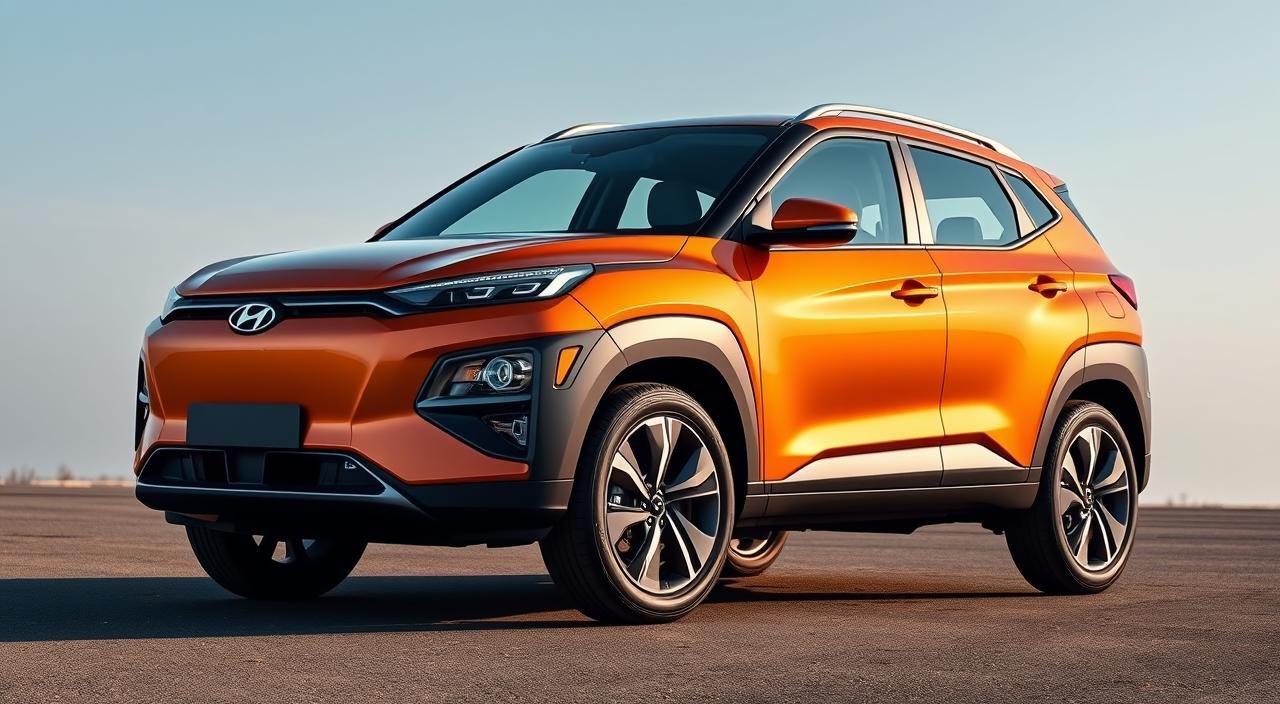
Oct
India’s electric vehicle market is set to explode, growing from 1.5 million units in 2023 to 10 million by 2030. Hyundai sees this as a chance to make a big splash with its new electric SUV. It’s designed for those who want to go green but don’t want to spend a lot.
Hyundai’s electric SUV is a big move for the company in India. It’s priced lower than the Creta Electric, aiming at middle-class families. The car will be made mostly in India to keep costs low while keeping quality high.
Hyundai is set to release this SUV between late 2026 and early 2027. It’s part of a plan to bring seven new models to India by 2030. The car is built to be perfect for city driving and long weekend trips.
The team behind the SUV has focused on making it fit India’s roads and parking spots. It will go head-to-head with Tata Motors and MG Motor in the affordable electric car market. Early signs suggest it will have features usually found in pricier models.
Key Takeaways
- Hyundai’s compact EV SUV will launch in India between late 2026 and early 2027
- The vehicle sits below the Creta Electric in Hyundai’s lineup for better affordability
- High localization levels will help reduce manufacturing costs and final pricing
- Part of Hyundai’s plan to introduce 26 products in India by 2030
- Designed for Indian urban environments and highway conditions
- Will compete with Tata Motors and MG Motor in the affordable EV segment
Overview of the Hyundai Compact EV SUV
The Hyundai SUV launch in India is a big deal for electric cars. This small electric SUV is Hyundai’s way to meet the growing need for cheap electric cars in India. It’s built with the latest EV tech, making it both useful and high-tech.
What Makes It Unique?
This electric car is special because of its Connected Car Navigation Cockpit. It uses NVIDIA tech and has two big screens. These screens make the car feel like a digital world. It also has over 70 smart car features and can understand more than 400 voice commands in five languages, including Hindi, English, and Tamil.

Key Features to Anticipate
This small EV SUV has top-notch features. You can expect:
- Level 2 Advanced Driver Assistance Systems for better safety
- Over-the-air updates for easy software fixes
- A big sunroof for a fresh feel
- Ventilated seats for comfort in India’s weather
- Wireless phone charging
- Ambient lighting for a fancy look
- A digital instrument cluster with customizable screens
| Feature Category | Specifications |
|---|---|
| Display System | Dual 12.3-inch panoramic screens |
| Voice Commands | 400+ commands in 5 languages |
| Connected Features | 70+ smart connectivity options |
| Safety Technology | Level 2 ADAS suite |
Hyundai’s Commitment to Sustainability
Hyundai is leading the way in making cars better for the planet. It’s making electric vehicles in India. This shows the company cares about the environment and wants to meet the growing demand for green cars.
The Role of Electric Vehicles
Hyundai sees electric cars as key to cutting down on pollution in India. It plans to launch eight hybrid models by 2030. This move aims to make cities cleaner and greener.
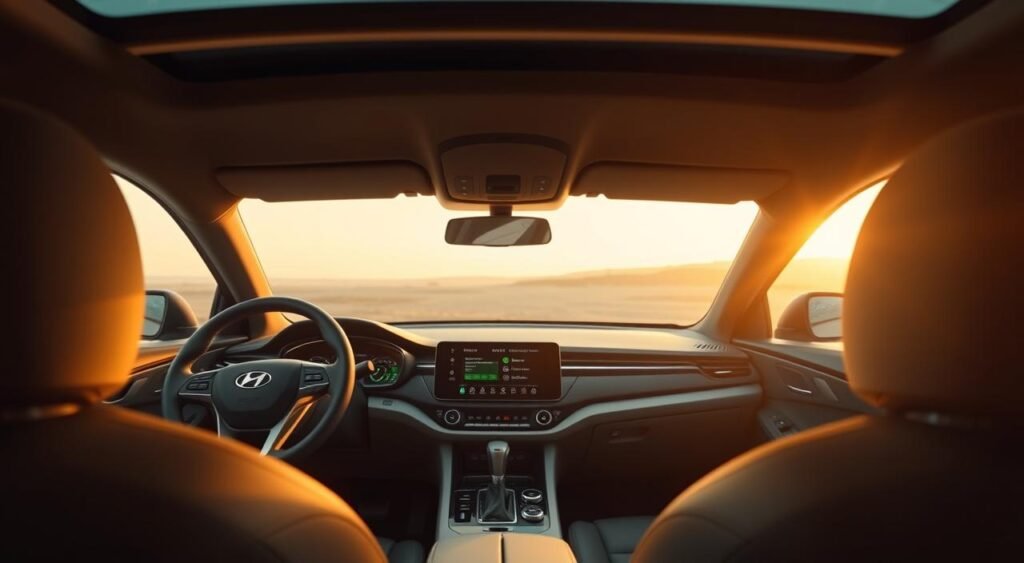
The Hyundai EV program focuses on making cars in India. This helps reduce pollution from shipping. The cars also use recycled materials, keeping them eco-friendly without losing comfort.
Eco-Friendly Production Processes
Hyundai’s factories use new methods to save energy and waste. The new SUVs will be made with 71% high-strength steel. This makes them strong yet lighter, saving energy.
- Recycled materials integrated into interior components
- High-strength steel construction reduces overall weight
- Localized production cuts transportation emissions
- Solar panels power manufacturing facilities
Hyundai’s factories run on solar power and recycle water. These steps make the Hyundai EV a smart choice for those who care about the planet.
Target Market for the Compact EV SUV
The Made-in-India Hyundai Compact EV SUV is for those who want an electric car but don’t want to spend a lot. It’s priced between Rs 10-18 lakh, making it perfect for middle-class families and young professionals. Its compact size is great for city driving, yet it has enough room for weekend trips.
Understanding Indian Consumer Preferences
Indian buyers look for value for money and practical features. Hyundai has carefully studied these preferences. They want electric cars that are reliable, have low running costs, and enough range for daily use. Space is also important, as one car often serves the whole family.

- Affordable pricing under Rs 18 lakh
- Minimum range of 300 kilometers
- Spacious interiors despite compact dimensions
- Strong service network coverage
- Low maintenance requirements
Competing Models in the EV Segment
The electric SUV market in India is competitive. The Tata Nexon EV leads with its good price and reliability. The MG ZS EV caters to those who want a premium option. The upcoming Maruti eVX and Kia Syros EV will add to the competition. Each model has its own strengths, giving buyers a wide range of choices.
Design Innovations in the New SUV
The new Hyundai electric SUV is designed for Indian roads and tastes. It’s based on the global Inster EV platform but has big changes for local markets. The design team removed quirky elements from international versions, making it look clean and sophisticated for Indian buyers.
Exterior Features and Aesthetics
The Indian Hyundai EV is small and perfect for city streets. Its sleek design is both modern and practical. The front has a closed grille and sharp LED headlights, making it stand out.
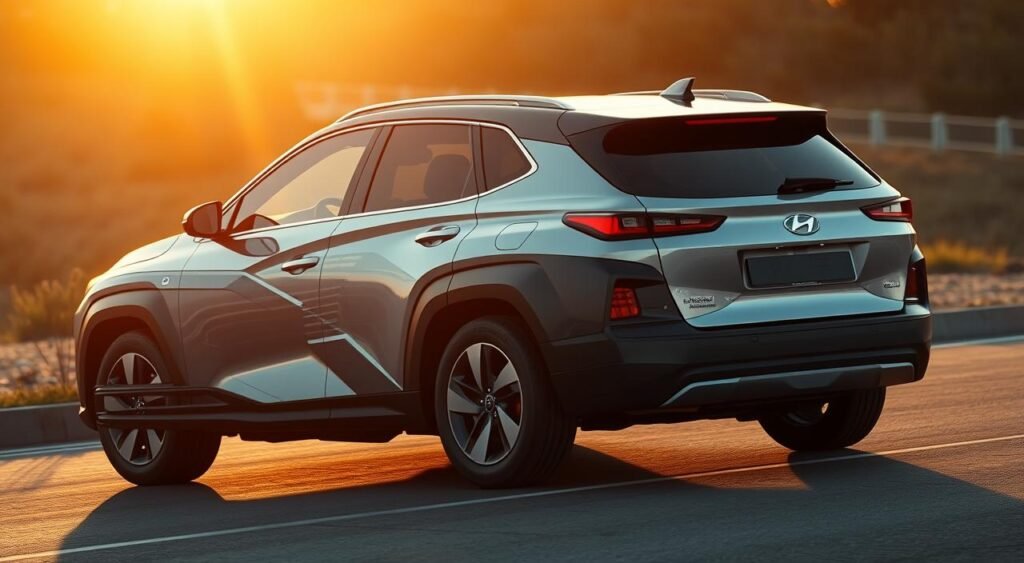
The sides have sculpted lines for better aerodynamics and a strong look. The designers added flush door handles and special alloy wheels for style and efficiency.
Interior Layout and Technology
Inside, the SUV feels luxurious with premium materials. You can pick from navy and dove grey upholstery with Moon White ambient lighting. This creates a calm mood for evening drives.
The tech highlight is the dual 12.3-inch curved displays. They merge the infotainment system with the digital driver cluster. This setup makes controlling the car and navigation easy. A Bose 8-speaker system is standard, making every drive a great audio experience.
Performance Specifications
The upcoming Hyundai SUV launch in India is set to impress with its performance. It offers efficient power and practical range options. This makes it perfect for city and highway driving. Plus, it stays up-to-date with remote updates, ensuring continuous improvements.
Powertrain Details
The electric motor in this SUV produces 100 to 120 PS of power. It provides smooth acceleration for daily drives and long trips. This setup means instant torque, lower costs, and better performance in all driving conditions.
Battery Range and Charging Options
Customers can pick from Standard Range or Long Range battery packs. The range is 300 to 350 kilometers per charge, depending on the battery. This choice lets buyers match their needs with their budget.
The Hyundai electric vehicle also comes with over-the-air (OTA) updates. These updates can enhance performance, add new features, and boost security. This means the SUV gets better and safer without needing a service visit.
Safety Features and Ratings
The India-made Hyundai EV is loaded with the latest safety tech. It’s designed to keep passengers safe in all driving scenarios. This electric SUV leads in safety with over 65 features built into its platform.
Advanced Driver Assistance Systems
The Hyundai compact SUV boasts a SmartSense ADAS Level 2 suite with 16 features. It has Smart Cruise Control for safe following distances. Forward Collision-Avoidance Assist can apply emergency brakes when needed.
Lane Keeping Assist helps prevent unintentional lane changes. It gently corrects steering.

All variants come with 33 essential safety features. They have six airbags for full protection. Electronic Stability Control keeps the vehicle stable during emergencies.
Hill-start assist prevents rollback on slopes. All-wheel disc brakes ensure confident stopping in various conditions.
Crash Test Ratings Expected
The India-made Hyundai EV has 71% high-strength steel construction in its body. This strong build is expected to perform well in crash tests. The blind spot view monitor shows camera feeds when turning.
A voice-enabled electric sunroof includes anti-pinch technology. Experts think this SUV will get top safety ratings. This is due to its advanced protection systems and sturdy construction for Indian roads.
Pricing Strategy and Variants
The Made-in-India Hyundai Compact EV SUV Coming Soon has a pricing plan made just for Indian buyers. The electric car market in India wants prices that are fair but not cheap. Hyundai aims to find this sweet spot by using more local parts and planning different models carefully.
Anticipated Price Range
The new electric SUV will start under Rs 10 lakh for the basic model. The top models with extra features and longer range will cost up to Rs 18 lakh. This pricing makes electric cars more affordable for many Indian families.
There will be two main battery options: Standard Range and Long Range. Each option will have different trims with various features and tech.
Comparison with Competing Models
The pricing in the compact electric SUV market is quite interesting:
| Model | Starting Price (Rs) | Top Variant (Rs) | Battery Range (km) |
|---|---|---|---|
| Hyundai Compact EV | 9.99 lakh | 18 lakh | 350-450 |
| Tata Nexon EV | 14.74 lakh | 19.94 lakh | 325-465 |
| Mahindra XUV400 | 15.49 lakh | 19.39 lakh | 375-456 |
| MG ZS EV | 21.99 lakh | 25.75 lakh | 419-461 |
The Made-in-India Hyundai Compact EV SUV Coming Soon is priced to compete well. Making it in India saves a lot of money compared to importing parts.
Distribution and Availability
The upcoming Hyundai electric SUV will be available across India. Hyundai plans to use its current dealership network. This way, customers can find the new Indian Hyundai EV in major cities and towns.
With over 550 showrooms and 1,350 service points, finding a place for test drives, purchases, and maintenance is easy. This makes buying and maintaining the vehicle convenient for everyone.
Launch Timeline in India
The Indian Hyundai EV is set to arrive between late 2026 and early 2027. Customers can book by paying Rs 25,000 at authorized dealerships. This timing fits with Hyundai’s plans to electrify the Indian market.
- Online reservations through Hyundai’s official website
- Offline bookings at dealership locations
- Priority delivery based on booking sequence
- Flexible payment options including EMI schemes
Expansion Plans Beyond India
After India, the Hyundai electric SUV will go to Southeast Asia and Africa. Hyundai’s Chennai plant will be the export hub. Genesis, Hyundai’s luxury brand, will also come to India in 2027.
This move will make Hyundai a major player in the global EV market. It will also make India a key production center for new markets.
Customer Experience and After-Sales Service
The new Hyundai SUV launch in India comes with top-notch customer support. It sets a high bar for electric vehicles. You’ll find extensive service coverage through Hyundai’s wide network of dealerships and service centers across the country.
Hyundai has trained its technicians well for the electric vehicle release. This ensures your vehicle gets the best maintenance.
Hyundai’s Service Network
Hyundai has over 530 dealerships and 1,350 service points in India. Each place is equipped for electric vehicle servicing. They also offer over-the-air (OTA) updates to boost your SUV’s performance without needing a visit to the dealership.
The vehicle supports voice commands in five regional languages: Hindi, English, Tamil, Telugu, and Bengali. This makes the technology easy for many Indian customers to use.
Warranty and Maintenance Plans
Hyundai has great warranty packages for its electric SUV:
| Coverage Type | Duration | Kilometers |
|---|---|---|
| Vehicle Warranty | 3 years | Unlimited |
| Battery Pack | 8 years | 160,000 km |
| Roadside Assistance | 3 years | Unlimited |
| Free Maintenance | 3 years | 40,000 km |
The SUV comes with premium comfort features. These include an electric 4-way driver seat adjustment with ventilation, rear window sunshades, and reclining rear seats. These features make the SUV a great choice for Indian families looking for luxury in an electric vehicle.
Conclusion: The Future of Hyundai in India
Hyundai is set to change India’s electric vehicle market with its smart plan for affordable electric cars. The company aims to launch seven new models by 2030. This shows Hyundai knows what Indian buyers want and can afford.
The India-made Hyundai EV will focus on the growing middle class. They want cars that are good for the planet.
Predictions for Market Impact
The new Hyundai compact SUV is made to fill a gap in India’s EV market. It will have a name that shows it’s made for India. Experts think it will compete with Tata Nexon EV and MG ZS EV.
Hyundai plans to keep prices low by making more of the car in India. This will also help it meet India’s emission rules.
Final Thoughts on the Compact EV SUV
Hyundai is also working on more SUVs, including family movers and off-road vehicles. The company is all about making cars that are good for the planet and made locally. With a strong service network and good reputation, Hyundai is ready to take a big share of the market.
The compact EV SUV is just the start of Hyundai’s electric journey in India.
FAQ
When will the Made-in-India Hyundai Compact EV SUV launch?
The Hyundai electric SUV is set to hit the Indian market between late 2026 and early 2027. It’s part of Hyundai’s plan to introduce seven new models in India by 2030.
What is the expected price range for the Indian Hyundai EV?
The electric SUV is expected to start at under Rs 10 lakh for the base model. The top model could go up to Rs 18 lakh ex-showroom. This pricing aims to compete with the Tata Nexon EV and Kia Syros EV.
Which platform will the Hyundai SUV launch India model use?
The SUV will likely use the Hyundai Inster EV platform or a Venue EV variant. It’s been modified for the Indian market, focusing on cleaner looks and removing quirky designs.
What are the key features of the Hyundai electric vehicle release?
The SUV boasts Level 2 ADAS with 16 driver assistance features. It has dual 12.3-inch displays and a premium sound system by Bose. It also features a panoramic sunroof, ventilated seats, and wireless charging. The system supports over 400 voice commands in five languages.
What battery options and range will the Hyundai compact SUV details include?
The EV will have Standard Range and Long Range battery packs. It’s expected to have a range of 300-350 km. The electric motor produces 100-120 PS for fast performance, with OTA updates for continuous improvement.
How does the India-made Hyundai EV support sustainability?
Hyundai uses recycled materials in the interior and focuses on environmental goals. The SUV is built with 71% high-strength steel for durability. Hyundai plans to launch eight hybrid models by FY2030.
What safety features are included in the Hyundai upcoming SUV news?
The SUV has over 65 safety features, with 33 standard across all models. It includes six airbags, ESC, and hill-start assist. It also has a blind spot view monitor and voice-enabled electric sunroof. The Hyundai SmartSense ADAS Level 2 system offers Smart Cruise Control and more.
How can customers book the new Hyundai electric SUV in India?
Bookings are available through Hyundai’s nationwide network with a Rs 25,000 token. Customers will enjoy Hyundai’s service infrastructure and OTA updates for continuous improvement. This enhances the ownership experience.

Oct
What new cars hit the Indian market in September 2025? This month was big for car buyers. Many car makers brought out new models at different prices.
The new cars in September 2025 offered something for everyone. The Volvo EX30 electric SUV was priced at Rs. 39.99 Lakh. On the other end, the Citroen Basalt X started at just Rs. 7.95 Lakh. Maruti Suzuki introduced the Victoris at Rs. 10.50 Lakh. VinFast also made its debut with the VF 6 and VF 7.
These new cars are just the start of a big change in India’s car market. By 2026, 68 new cars will hit the roads, including 50 SUVs. Each car comes with new features and tech to meet what buyers want.
Key Takeaways
- Volvo EX30 electric SUV launched on September 23, 2025, priced at Rs. 39.99 Lakh
- Maruti Suzuki Victoris debuted on September 15, 2025, at Rs. 10.50 Lakh
- VinFast entered India with VF 6 (Rs. 16.49 Lakh) and VF 7 (Rs. 20.89 Lakh) models
- Citroen Basalt X launched as the most affordable option at Rs. 7.95 Lakh
- 68 new vehicles scheduled for 2025-2026, with SUVs dominating at 50 models
- September launches covered all segments from budget to luxury vehicles
Overview of September 2025 Car Launches
September 2025 was a big month for cars in India. Car makers brought out a wide range of vehicles. Prices started at Rs. 7.95 Lakh for the Citroen Basalt X and went up to Rs. 39.99 Lakh for the Volvo EX30. This shows how the market is changing to meet different needs and budgets.

Significance of New Launches
The new cars in September highlight a big move towards electric and SUVs. *Volvo’s entry into the premium EV segment* shows a push for green transport. With 16 new models coming in the next three months, the industry is feeling optimistic about India’s growth.
For those watching their wallets, there’s the Citroen Basalt X. And for those looking for luxury, there’s the Volvo. This variety means there’s something for everyone, no matter their budget.
Key Trends in the Automotive Market
SUVs are all the rage, with 50 models on the way. Electric cars are also getting more attention, thanks to eco-friendly goals and government rules. Prices range from Rs. 7.95 Lakh to Rs. 39.99 Lakh, showing a smart strategy to reach various customers. These updates show the industry is ready to meet new demands and prepare for the future.
Major Brands and Their Releases
The upcoming cars in September 2025 show a big fight among India’s top car makers. Each brand has something special for everyone, from those on a tight budget to those wanting the best. The latest cars highlight the need for good prices, new tech, and more choices.
Tata Motors: Innovations and Updates
Tata Motors is growing fast with four big new cars. The Tata Sierra is back as a modern SUV, priced between Rs. 15-25 Lakh. It’s perfect for those who love adventure.
The Harrier and Safari get big updates. The Harrier costs between Rs. 14-25.25 Lakh, and the Safari from Rs. 14.66-25.96 Lakh. The Punch 2025 starts at just Rs. 6 Lakh, making it very affordable.
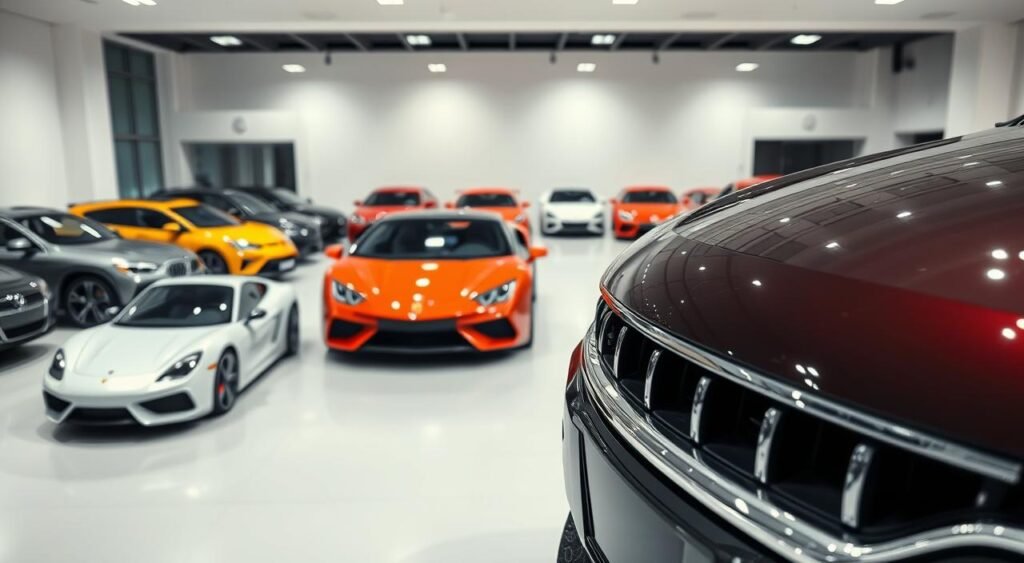
Hyundai: Exciting New Models
Hyundai is bringing a variety of cars in September. The Venue 2025 starts at Rs. 8 Lakh, aiming for the compact SUV market. The Tucson 2025, priced at Rs. 30 Lakh, offers high-end features.
The Palisade, priced between Rs. 40-50 Lakh, shows Hyundai’s move into luxury. It’s a big step for the brand.
Maruti Suzuki: The Affordable Option
Maruti Suzuki is getting stronger with the Victoris at Rs. 10.50 Lakh. They also have the updated Brezza 2025 at Rs. 8.50 Lakh and the Grand Vitara at Rs. 14 Lakh. The e Vitara is their first electric car, priced between Rs. 17-22.50 Lakh.
Electric Vehicles Introduced in September 2025
The electric vehicle segment was a big hit in September 2025. India saw many new EVs, from affordable models to luxury ones. This shows more people want green cars in India.
Leading EVs in the Lineup
Volvo’s EX30 electric was a highlight, priced at Rs. 39.99 Lakh. It shows the push for high-end electric cars. There are also cheaper options like the Leapmotor T03 at Rs. 8 Lakh and the Maruti WagonR Electric at Rs. 8.50 Lakh. These make electric cars more affordable for everyone.
| Electric Vehicle Model | Price Range (Rs.) | Market Segment |
|---|---|---|
| Leapmotor T03 | 8 Lakh | Budget |
| Maruti WagonR Electric | 8.50 Lakh | Budget |
| Mahindra XEV 4e | 13 Lakh | Compact |
| Maruti e Vitara | 17-22.50 Lakh | Mid-Range SUV |
| MG 4 EV | 30 Lakh | Premium |
| Tesla Model 3 | 60 Lakh | Luxury |
| BMW iX 2025 | 1.45 Crore | Ultra-Luxury |
Government Initiatives for EV Adoption
The Indian government is helping by giving FAME-II subsidies and lowering GST rates. States also offer perks like free registration and special parking. These moves make electric cars more appealing to all buyers.
Compact Cars: A Growing Segment
The compact car segment is booming in India. Many new cars are coming out, aiming at budget-friendly buyers. These cars are great for city driving, saving money, and using less fuel.
They offer a perfect mix of space, features, and price. This makes them ideal for Indian roads and parking spots.
Best Compact Cars Launched
Citroen introduced the Basalt X for Rs. 7.95 Lakh on September 5, 2025. Its price makes it a great choice for new buyers. The Maruti Swift is also popular, priced from Rs. 5.79 to 8.80 Lakh. It’s known for its reliability and wide service network.
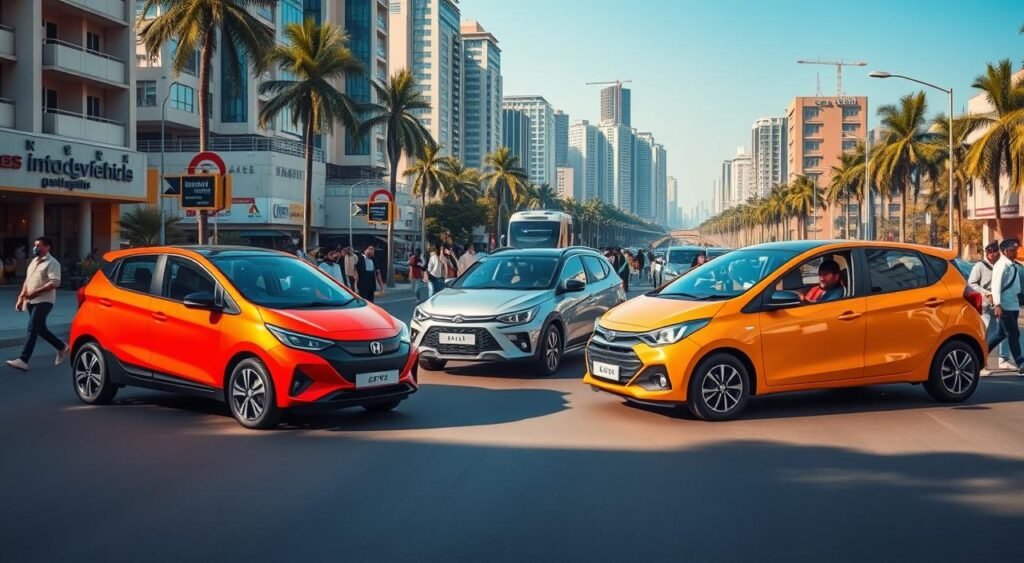
Several new models are expected to change the compact car scene. The Tata Punch 2025 facelift will cost around Rs. 6 Lakh. Volkswagen’s Tera will start at Rs. 8 Lakh. VinFast’s VF 3 will be priced between Rs. 7.50 and 10 Lakh. Honda’s WR-V is expected to cost between Rs. 9 and 12 Lakh.
Consumer Preferences and Trends
People looking for compact cars want good value, fuel efficiency, and low upkeep. Renault answered with new KWID models priced from Rs. 4.30 to 5.90 Lakh. The upcoming Maruti Baleno 2026 and MG 4 EV show a shift towards electric cars. They keep the compact size but add modern tech features.
SUVs and Crossovers: Dominating the Market
The SUV segment is leading the way on Indian roads with exciting new launches in 2025. September saw big unveilings from both well-known brands and new players. These launches set new benchmarks for design and performance.
The latest car models in India show a growing need for versatile vehicles. They must offer family comfort and be ready for adventure.
Popular SUV Models Unveiled
VinFast introduced their VF 6 and VF 7 electric SUVs, priced at Rs. 16.49 Lakh and Rs. 20.89 Lakh. The Mahindra Thar arrived in October, starting at Rs. 9.99 Lakh. It’s a hit with off-road fans across the country.
More exciting launches are on the horizon. We can expect:
- Hyundai Palisade – Rs. 40-50 Lakh
- Maruti Brezza 2025 – Rs. 8.50 Lakh
- Tata Sierra – Rs. 15-25 Lakh
- Volkswagen Tayron – Rs. 50 Lakh
- Renault New Duster – Rs. 12-20 Lakh
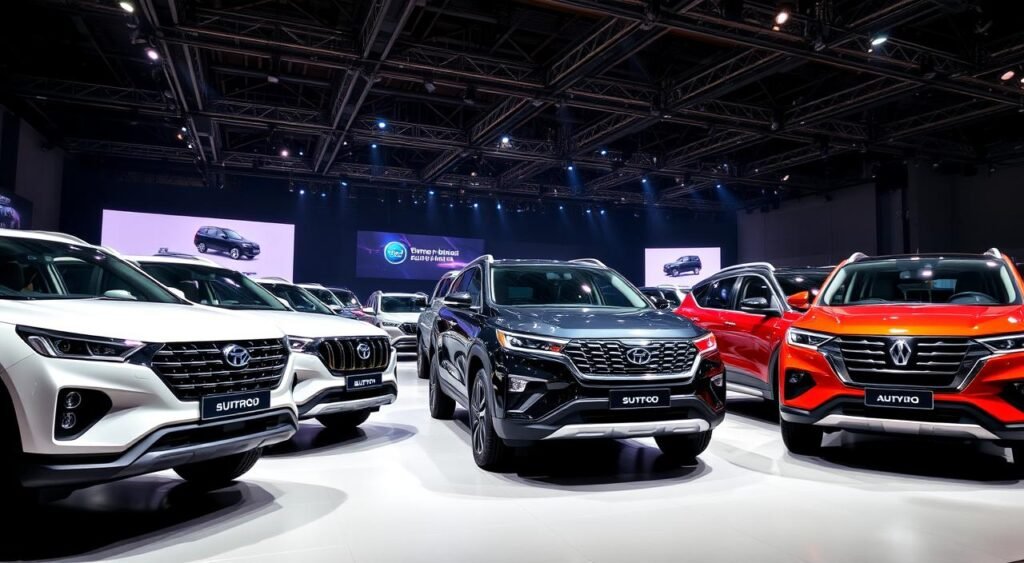
Features That Attract Buyers
Today’s SUV buyers look for advanced safety systems, roomy interiors, and good fuel economy. The latest models offer ADAS technology, panoramic sunroofs, and connected car features. They also have three-row seating options from Toyota and Maruti Grand Vitara for families.
Premium options like the MG Majestor at Rs. 46 Lakh add luxury to the segment. By 2026, nearly 50 SUVs will hit the market. Each will bring its own mix of tech, comfort, and value to Indian buyers.
Luxury Vehicles: Premium Offerings
September 2025 is a big month for luxury car buyers in India. The luxury car segment welcomes new models. These cars combine the latest technology with top-notch craftsmanship.
High-End Brands and Their New Arrivals
*Volvo* starts with the EX30, a premium electric vehicle, launched on September 23, 2025, at Rs. 39.99 Lakh. It brings Scandinavian design to India. Mercedes-Benz also makes a splash with the AMG CLE, priced at Rs. 1.28 Crore.
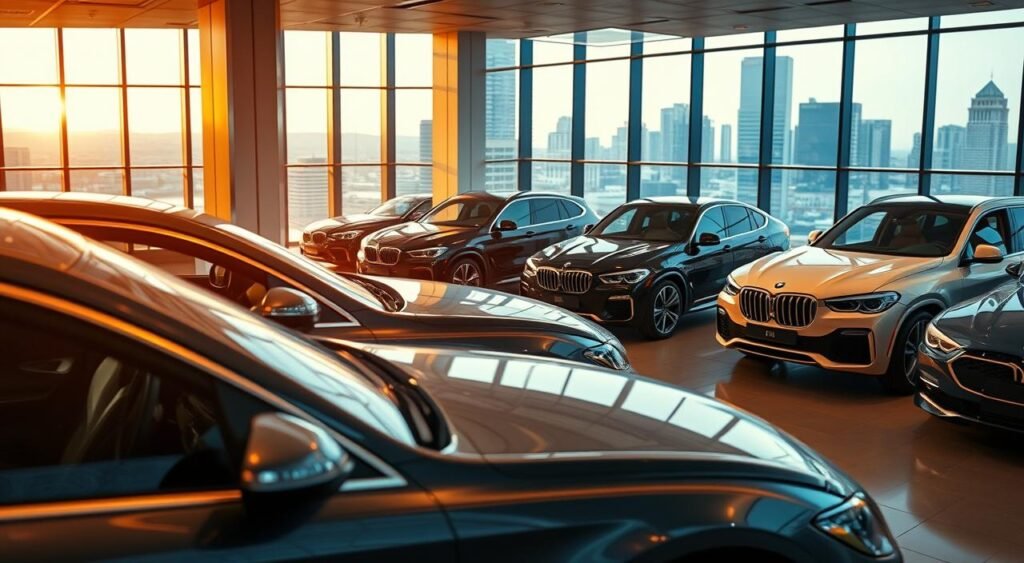
More excitement is coming. BMW is set to introduce the iX 2025 at Rs. 1.45 Crore. Audi will launch two models: the Q6 e-tron at Rs. 1 Crore and the A5 at Rs. 50 Lakh. Skoda is targeting the premium sports sedan market with the Octavia RS, expected between Rs. 45-55 Lakh.
Unique Selling Points of Luxury Cars
These premium vehicles stand out for several reasons:
- Advanced autonomous driving capabilities
- Sustainable luxury with electric powertrains
- Personalized digital cockpits
- Handcrafted interiors using premium materials
- Exclusive ownership experiences and services
Ferrari introduces the 12Cilindri coupe, while Maserati brings the MCPura at Rs. 5.12 Crore. These updates show a focus on performance and environmental care.
Technology and Features in New Cars
September 2025 is a big moment for the India car market. Cars now come with the latest tech, from electric power to smart connectivity. The newest models mix safety with fun tech, pleasing tech lovers at all price points.
Advanced Safety Features
New cars focus on safety first. The BMW iX 2025 has Level 2 driving, helping with steering and speed. Tesla Model 3 brings Autopilot to Indian roads, making driving easier in traffic.
The Maruti e Vitara offers six airbags and stability control for less money. Volvo EX30 keeps up its safety promise with a top-notch collision system. These features show India’s push for safer cars for everyone.
Infotainment and Connectivity Options
Digital cockpits are changing how we drive. Mercedes-Benz CLA Electric has a top-notch MBUX system, understanding Hindi and English voice commands. Hyundai IONIQ 6 has two big screens and supports Apple CarPlay and Android Auto without wires.
The Audi Q6 e-tron shows off with a virtual cockpit and real-time charging station info. These features highlight India’s move toward cars that connect well with phones and homes.
Pricing Trends and Market Analysis
The car market in September 2025 saw a variety of prices for new cars. Prices ranged from affordable compact cars to high-end luxury vehicles. This shows how the Indian car market is changing and what buyers want.
Comparison of Launch Prices
New cars in September 2025 offer a wide price range for different buyers. The cheapest models are priced to be affordable, while the most expensive ones are in the luxury category.
| Car Model | Segment | Price (Rs. Lakh) |
|---|---|---|
| Tata Punch 2025 | Budget | 6.00 |
| Citroen Basalt X | Compact | 7.95 |
| Volkswagen Tera | Budget | 8.00 |
| Leapmotor T03 | Electric Budget | 8.00 |
| Maruti Victoris | Mid-Segment | 10.50 |
| VinFast VF 6 | Electric SUV | 16.49 |
| VinFast VF 7 | Electric SUV | 20.89 |
| Volvo EX30 | Luxury Electric | 39.99 |
| Audi Q6 e-tron | Premium Electric | 100.00 |
| BMW iX 2025 | Ultra-Luxury | 145.00 |
Economic Factors Influencing Pricing
Many economic factors affect the prices of new cars in September 2025. Rising raw material costs and changes in the supply chain increase production costs. Electric cars range from Rs. 8 Lakh to Rs. 65 Lakh, showing how manufacturers aim for different price points. Government support for electric vehicles also plays a big role in setting prices. Changes in currency value impact the cost of imported parts, affecting high-end brands like BMW and Audi.
Customer Reactions and Reviews
The latest car releases in September 2025 have started big talks in car forums and dealerships everywhere. People are sharing their thoughts on new cars, helping others make up their minds. This feedback is key for millions of people thinking about buying a car.
Feedback on Latest Models
The Mahindra Thar’s launch in October at Rs. 9.99-16.99 Lakh caught everyone’s attention. Early buyers loved its tough look and how well it handles off-road. The Maruti Victoris, launched on September 15 at Rs. 10.50 Lakh, got good feedback for its gas mileage and roomy inside.
VinFast’s arrival in India with the VF 6 and VF 7 models made a big splash. People liked the brand’s good prices and cool features. The Volvo EX30 electric car, priced at Rs. 39.99 Lakh, drew in fans of eco-friendly luxury cars.
The Role of Social Media in Reviews
Instagram and YouTube channels focused on cars got a lot of attention in September 2025. Videos about the Maruti Swift (Rs. 5.79-8.80 Lakh) and Tata Nexon (Rs. 7.32-14.05 Lakh) were watched by millions. Twitter talks about the Tata Punch (Rs. 5.50-9.30 Lakh) and Maruti FRONX (Rs. 6.85-11.98 Lakh) helped shape buying choices in big cities.
Online groups are now very important in forming opinions about new cars. Quick feedback on social media helps car makers fix problems and make customers happier.
Conclusion: What’s Next for the Indian Automotive Market?
The Indian car market is on the verge of a big change. By 2026, 68 new models will hit the roads. SUVs will lead with 50 models, while sedans, hatchbacks, and electric vehicles will also be available.
September 2025 will see a wide range of cars. Prices will start at Rs. 6 Lakh for the Tata Punch 2025. The Maserati MCPura will be at the high end, priced at Rs. 5.12 Crore.
Future Predictions
The next 18 months will bring many new cars to India. Mahindra will launch the new Bolero in March 2026. Hyundai will introduce the New Venue in November 2025 and the Palisade in March 2026.
Electric cars will become more common, with over 12 models debuting. This includes the Tesla Model 3 and Maruti WagonR Electric. There will also be specialized vehicles like the Mahindra Global Pik Up and Nissan Compact MPV.
Implications for Consumers and Manufacturers
Car buyers in India will have more choices than ever. The September 2025 list shows a wide range of options. Manufacturers must balance price and innovation to meet customer needs.
The move towards electric vehicles and SUVs marks a new era. Companies must quickly adapt to these changes. They also need to keep prices affordable in the Indian market.
FAQ
Which cars were launched in India in September 2025?
In September 2025, India saw five big car launches. The Volvo EX30 electric SUV was launched on September 23 at Rs. 39.99 Lakh. The Maruti Suzuki Victoris was launched on September 15 at Rs. 10.50 Lakh. VinFast VF 6 and VF 7 SUVs were launched on September 6 at Rs. 16.49 Lakh and Rs. 20.89 Lakh respectively. The Citroen Basalt X was launched on September 5 starting at Rs. 7.95 Lakh.
What are the price ranges for new car launches in September 2025?
The new car launches in September 2025 offered a wide range of prices. The Citroen Basalt X started at Rs. 7.95 Lakh. The Volvo EX30 electric SUV was priced at Rs. 39.99 Lakh. The Maruti Suzuki Victoris was priced at Rs. 10.50 Lakh. The VinFast models were priced at Rs. 16.49-20.89 Lakh.
Which electric vehicles are coming to India in 2025-2026?
Over 12 electric vehicles are coming to India. The BMW iX 2025 will cost Rs. 1.45 Crore. The Audi Q6 e-tron will cost Rs. 1 Crore. The Maruti e Vitara will cost between Rs. 17-22.50 Lakh. The Mercedes-Benz CLA Electric will cost Rs. 65 Lakh. The MG 4 EV will cost Rs. 30 Lakh. The Tesla Model 3 will cost Rs. 60 Lakh. The Mahindra BE 07 will cost Rs. 29 Lakh. The Maruti WagonR Electric will cost Rs. 8.50 Lakh. The Leapmotor T03 will cost Rs. 8 Lakh.
How many upcoming cars are scheduled for launch in India?
India has 68 upcoming cars scheduled for 2025-2026. This includes 50 SUVs, 9 sedans, 4 hatchbacks, 2 coupes, 1 pickup truck, 1 MUV, and 1 luxury vehicle.
What are the top car releases expected in September 2025 and beyond?
Some key releases include the Maruti Brezza 2025 at Rs. 8.50 Lakh. The Hyundai Venue 2025 will cost Rs. 8 Lakh. The Tata Sierra will cost between Rs. 15-25 Lakh. The Hyundai Palisade will cost between Rs. 40-50 Lakh. The Maruti Grand Vitara 3-row will cost Rs. 14 Lakh. The Volkswagen Tayron will cost Rs. 50 Lakh. The Mahindra XUV700 Facelift will cost Rs. 15 Lakh.
Which budget cars under Rs. 10 Lakh are launching soon?
Soon, we’ll see budget-friendly cars like the Tata Punch 2025 facelift at Rs. 6 Lakh. The Volkswagen Tera will cost Rs. 8 Lakh. The VinFast VF 3 will cost between Rs. 7.50-10 Lakh. The Leapmotor T03 electric will cost Rs. 8 Lakh. The Maruti WagonR Electric will cost Rs. 8.50 Lakh. The Hyundai Venue 2025 will cost Rs. 8 Lakh.
What luxury cars are coming to the Indian market?
Luxury cars include the BMW iX 2025 at Rs. 1.45 Crore. The Audi Q6 e-tron will cost Rs. 1 Crore. The Skoda Octavia RS will cost between Rs. 45-55 Lakh. The Audi A5 will cost Rs. 50 Lakh. The Skoda Superb 2025 will cost Rs. 50 Lakh. The Mercedes-Benz CLA Electric will cost Rs. 65 Lakh. The Ferrari 12Cilindri coupe and Maserati MCPura will be launched on October 4, 2025, at Rs. 5.12 Crore.
What are the latest car models featuring advanced technology?
New models include the BMW iX 2025 with autonomous driving. The Tesla Model 3 has Autopilot. The Mercedes-Benz CLA Electric has the MBUX infotainment system. The Audi Q6 e-tron has quattro electric all-wheel drive. Many models feature ADAS technology and connected car features.
Which SUVs are dominating the Indian car market trends?
SUVs are leading the market with 50 models in the pipeline. The Mahindra Thar was launched on October 3, 2025, at Rs. 9.99-16.99 Lakh. The Tata Sierra, Maruti Grand Vitara 3-row, Hyundai Tucson 2025, MG Majestor, Toyota 3-Row SUV, Nissan New Compact SUV, and Renault New Duster are also expected.
What are the automobile industry updates for compact cars?
The compact segment is active with the Citroen Basalt X launched at Rs. 7.95 Lakh. Upcoming models include the Tata Punch 2025 and Honda WR-V at Rs. 9-12 Lakh. There are also 4 new hatchbacks, including the Maruti Baleno 2026. The Renault KWID has new variants at Rs. 4.30-5.90 Lakh. The Maruti Swift remains popular at Rs. 5.79-8.80 Lakh.
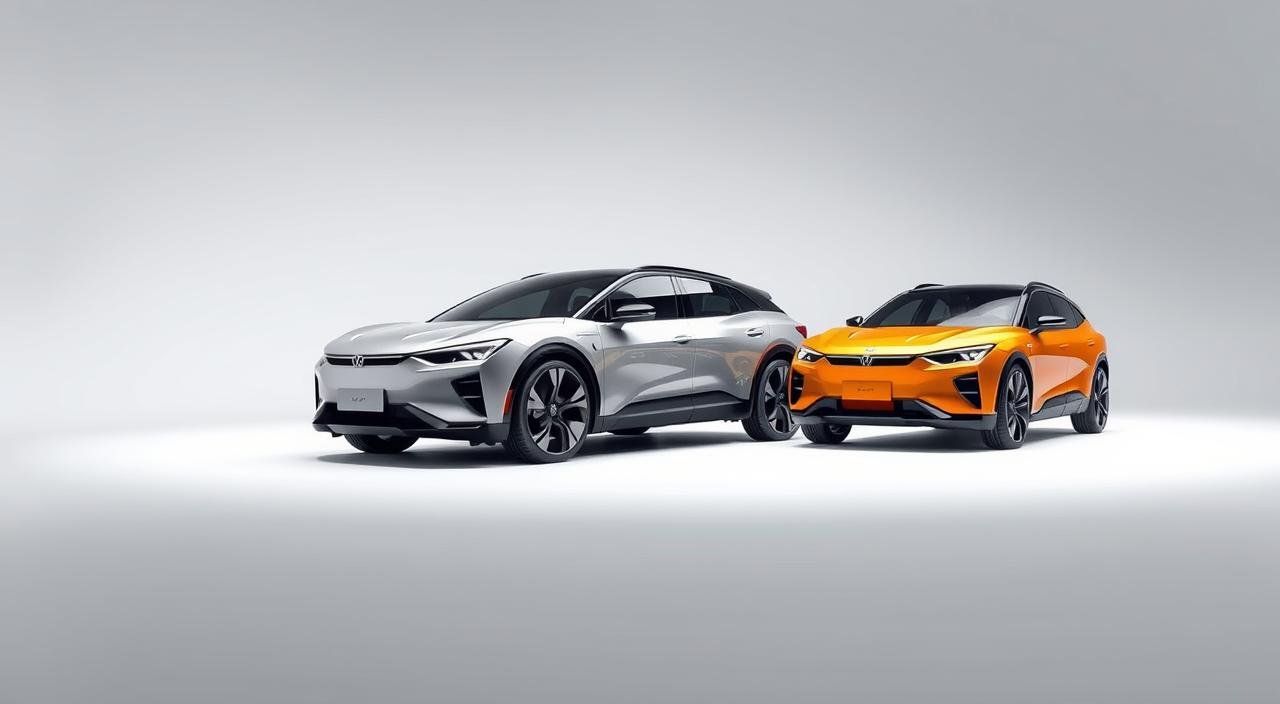
Oct
Can a Vietnamese automaker challenge the big names in India’s electric vehicle market? VinFast said yes with a big move on Saturday. They launched the VF6 and VF7 models, priced starting at ₹16.49 lakh.
The launch of VinFast VF6 & VF7 in India is a big deal for the Vietnamese company. CEO Pham Sanh Chau shared big plans. They plan to make cars in India and sell them in South Asia, Africa, and the Middle East.
VinFast started taking bookings in July for ₹21,000. They teamed up with 13 dealer groups to open 32 dealerships in 27 cities. They aim to grow to 35 dealerships by 2025.
The VF6 starts at ₹16.49 lakh and has 423 liters of boot space. It has a 468 km range. The VF7 starts at ₹20.89 lakh, with 537 liters of boot space and a 438-532 km range. It comes in five variants.
Key Takeaways
- VinFast VF6 starts at ₹16.49 lakh while VF7 begins at ₹20.89 lakh (ex-showroom)
- Indian-made vehicles will export to South Asia, Africa, and Middle East regions
- 32 dealerships established across 27 cities with expansion to 35 by 2025
- VF6 offers 468 km range with 423 liters boot space
- VF7 provides 438-532 km range with 537 liters boot space
- Both models available in multiple variants to suit different customer needs
Overview of VinFast’s Entry into the Indian Market
VinFast Auto Ltd. is entering India with the VinFast VF6 & VF7 priced from ₹16.49 lakh. This move is a big step for VinFast, known for electric vehicles in Vietnam. The company hopes to make a mark in India’s fast-growing EV market.
Background of VinFast
VinFast is led by chairman Pham Nhat Vuong, part of the Vingroup group. They have a wide range of businesses, including healthcare and education. In Vietnam, VinFast’s electric vehicles are a common sight.
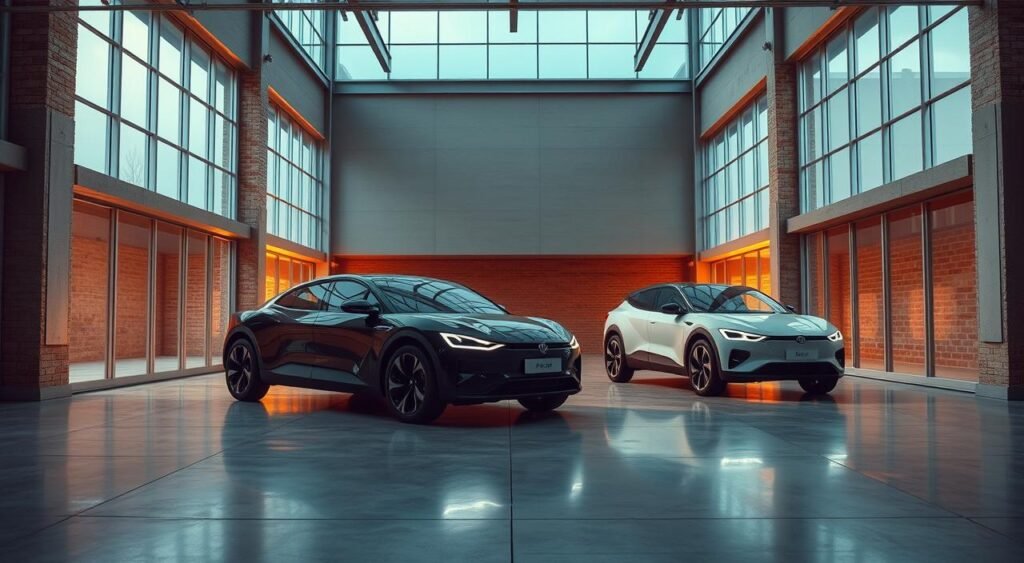
Importance of the Indian Market
India is key for VinFast’s growth plans. The country saw 18.78 million EV sales in 2024, making up 7.6% of all vehicle sales. Electric car sales jumped 93% in July. India aims for 30% electric vehicles by 2030, a big opportunity for VinFast.
Key Objectives for Launching the VF6 & VF7
VinFast is investing $500 million in a new factory in India. The plant will start with 50,000 vehicles and could reach 150,000. This base will help VinFast reach more markets, competing with big names like Tata Motors and Maruti Suzuki.
Features of the VinFast VF6
The VinFast VF6 is a fresh addition to India’s electric vehicle scene. It’s a compact SUV that blends modern looks with useful tech. This makes it a great choice for city drivers. The VinFast VF6 offers a smart mix of power and efficiency.
Design and Aesthetics
The VF6 has a young, coupe-like design that catches the eye. Its closed-off grille adds to its sleek look, common in electric cars. LED projector headlights and V-shaped LED daytime running lights create a unique front.
The side view shows short rear overhangs and a sloping roof for better aerodynamics. Black cladding protects the lower parts, while dual-tone alloy wheels add style. At the back, cuts and creases add interest, with a roof spoiler and light bar mirroring the front.
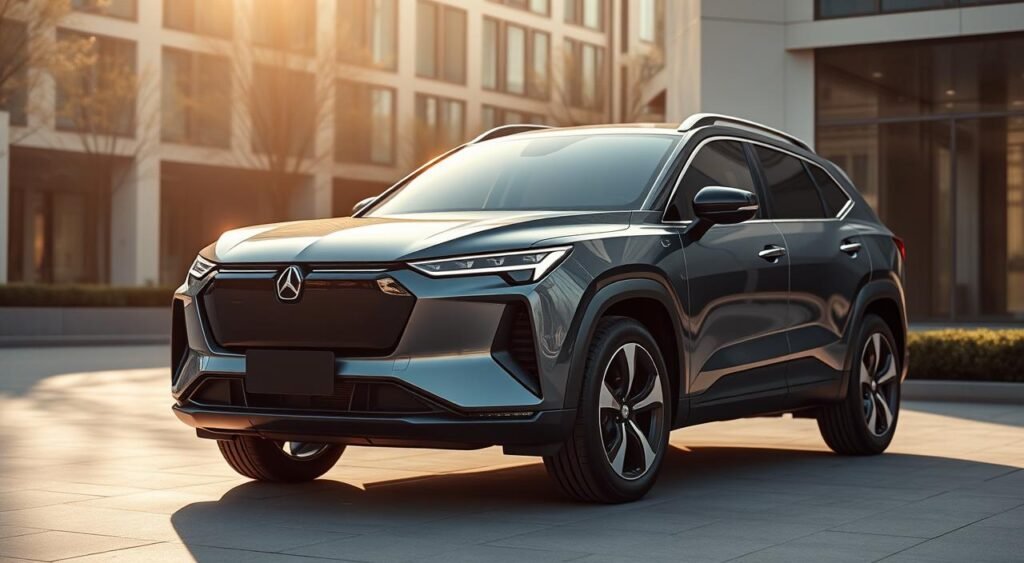
Interior Technology
The VF6’s interior is simple yet tech-rich. You can pick from black or Mocha brown themes, with soft-touch materials everywhere. The 12.9-inch touchscreen is the main attraction, running Google apps and voice commands. A flat-bottom steering wheel and button gear selector add to the modern feel.
Performance Capabilities
The VinFast VF6 & VF7 boast strong electric powertrains. The VF6 has 174 to 201.15 bhp from its 59.6 kWh battery. It goes from 0-100 kmph in 9 seconds and tops out at 175 kmph. Its 468 km range is perfect for daily drives and weekend getaways. DC fast charging fills 10-70% of the battery in just 25 minutes.
Features of the VinFast VF7
The VinFast VF7 is a top pick in India’s electric SUV market. It’s known for its bold design and strong performance. The VinFast VF7 specifications show it’s a mix of style and substance, matching the big names in the field.
Exterior Design Highlights
The VF7 looks aggressive and futuristic. Its body has sharp lines that grab attention. The front has a unique grille and V-shaped LED lights that meet the VinFast logo.
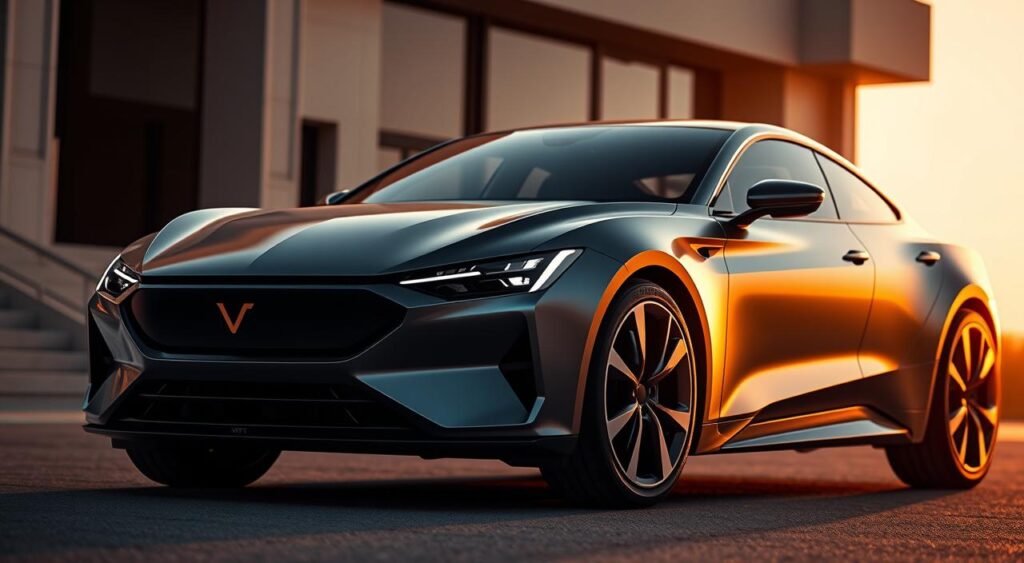
- All-LED projector headlights with mesh-pattern air intake
- 19-inch dual-tone alloy wheels
- Flush door handles for improved aerodynamics
- Connected LED taillights with sculpted rear bumper
- Shark fin antenna and ORVM-mounted turn indicators
Advanced Safety Features
The VinFast VF6 & VF7 review highlights its safety features. It has seven airbags and Level-2 ADAS. This includes Adaptive Cruise Control and Lane Centering.
A 360-degree camera system gives full view around the car. Rain-sensing wipers and an electronic parking brake make driving safer and easier.
Driving Experience
The VF7 offers thrilling performance with different powertrains. It has battery options from 59.6 kWh to 70.8 kWh. The top AWD model goes from 0-100 kmph in 5.8 seconds.
Its range is 438 to 532 km on the NEDC cycle. VinFast guarantees the battery for 10 years or 200,000 km. They also offer free charging until July 2028.
Pricing and Variants of VF6 and VF7
VinFast has set its electric SUV prices to match India’s fast-growing EV market. The VinFast VF6 & VF7 come in various options for different needs and budgets. Starting at ₹16.49 lakh, they offer premium features at competitive prices.
Pricing Breakdown for Different Variants
The VF6 lineup has three main options. The Earth starts at ₹16.49 lakh with 130 kW power and 250 Nm torque. It has a sleek black interior.
The Wind variant is priced at ₹17.79 lakh. It boosts performance to 150 kW power and 310 Nm torque. It also comes with a sophisticated Mocha Brown interior.
The Wind Infinity variant at ₹18.29 lakh adds a panoramic fixed glass roof. This enhances the luxury feel.
The VF7 series offers five variants with advanced features. The Earth model starts at ₹20.89 lakh with a 59.6 kWh battery and 130 kW power.
The Wind variant at ₹23.49 lakh has a larger 70.8 kWh battery and 150 kW power. The Wind Infinity adds a panoramic roof for ₹23.99 lakh.
The Sky variant introduces dual motor AWD with 260 kW power at ₹24.99 lakh. The flagship Sky Infinity costs ₹25.49 lakh.
Comparison with Competitors
| Model | Starting Price | Top Price |
|---|---|---|
| VinFast VF6 | ₹16.49 lakh | ₹18.29 lakh |
| VinFast VF7 | ₹20.89 lakh | ₹25.49 lakh |
| MG Windsor EV | ₹14.00 lakh | ₹18.39 lakh |
| Tata Nexon EV | ₹12.49 lakh | ₹17.49 lakh |
| Hyundai Creta Electric | ₹18.02 lakh | ₹24.55 lakh |
VinFast VF6 & VF7 booking has started across India. Their prices are competitive, making them a great choice for both budget and premium electric vehicles. The VF6 goes up against Tata Curvv EV and MG ZS EV. The VF7 challenges models like Mahindra BE 6 and XEV 9e.
VinFast’s Production and Supply Chain Strategy
VinFast aims to be a big name in India’s electric car market. It plans to build a strong production base and a wide dealership network across the country.
Manufacturing Locations
VinFast’s Tamil Nadu plant is its third worldwide, after two in Vietnam. It started making cars on Monday, with a goal of 50,000 vehicles a year. It can make up to 150,000 cars as demand increases. VinFast India manufacturing mainly focuses on the VF6 and VF7 electric SUVs.

The company has put $500 million into its India growth. It aims to serve India and export to South Asia, the Middle East, and Africa.
Sustainability Practices
VinFast is all about green manufacturing, matching India’s clean car goals. Its Tamil Nadu plant uses energy-saving methods and only makes electric cars. This helps cut down on car emissions.
Supply Chain Innovations
VinFast VF6 & VF7 availability in India relies on a big dealership network in 27 cities. The first showroom opened in Surat in late July. By 2025, VinFast plans to have 35 dealerships. Currently, it has spots in big cities like Delhi and smaller ones like Shimla and Goa.
Targeting the Indian Consumer Demographics
VinFast sees India’s electric vehicle market growing fast, with a 93% increase in sales last July. The Vietnamese car maker aims to grab a piece of this growing market. Right now, electric vehicles make up 7.6% of all car sales in India.
Understanding the Target Audience
The VinFast target audience India is mainly people who want high-tech electric cars at good prices. They look for things like advanced safety features, big glass roofs, and fancy leather seats. VinFast aims to attract those who care about the environment and want luxury in their first electric car.
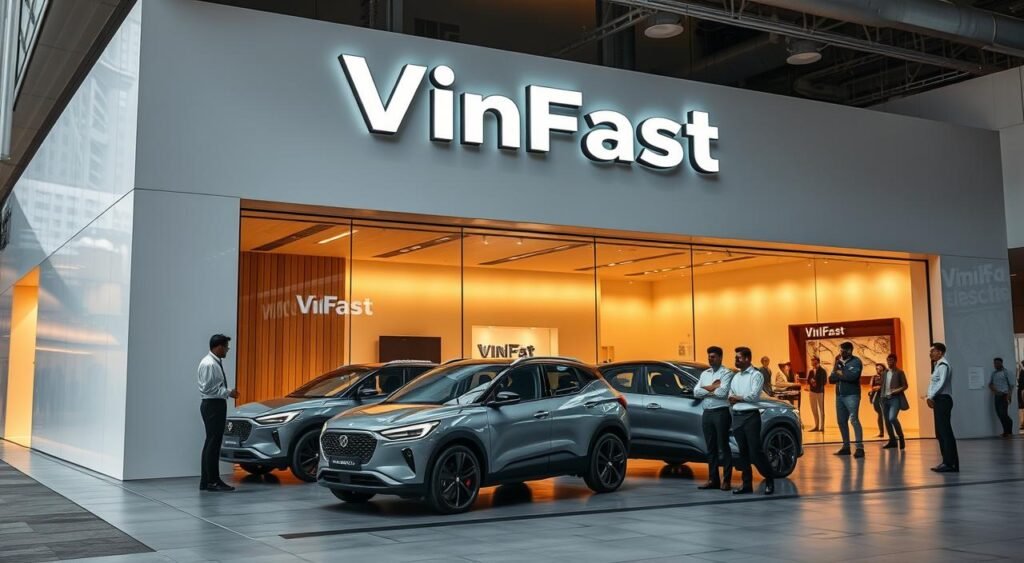
Marketing Strategies for India
The VinFast marketing strategy focuses on showing the brand’s global reach while being relevant to India. Key strategies include:
- Showing off Vietnamese heritage and success with 100 million users at home
- Starting prices that are competitive with Tata Motors
- Highlighting top-notch entertainment systems and safety features
- Supporting “Made in India” by assembling cars locally
Engagement with Local Communities
VinFast is building a strong presence in India with 13 dealer groups in big cities and EV hotspots. This move supports India’s goal of having 30% of cars be electric by 2030. The company also plans to use India as a base for exporting to South Asia, Africa, and the Middle East. This will create jobs and boost local economies.
Customer Experience and After-Sales Support
VinFast focuses on making customers happy with top-notch support. They bring advanced service to India, ensuring electric vehicle owners feel secure. Digital tools are key to a better experience for Indian buyers.
Warranty and Service Plans
The VinFast warranty India program is impressive, covering batteries for 10 years or 200,000 km. This shows VinFast’s faith in their battery tech. New owners get three years of free maintenance, cutting down costs early on.
- Free charging at VGreens stations until July 2028
- Edge-to-edge panoramic sunroof with complimentary curtain (select variants)
- Fast charging capabilities – VF6 reaches 70% in 25 minutes
- Auto LED projector headlamps and acoustic windshield as standard
Customer Feedback Mechanisms
The VinFast after-sales service will grow to 35 spots by 2025. The C-App connects customers and service centers instantly. It also makes linking phones easy with Android Auto and Apple CarPlay.
Updates can be sent over the air, keeping cars up-to-date without visits. This lets VinFast enhance features based on what customers say. The system also checks car health and plans maintenance on its own.
VinFast’s Future Plans in India
VinFast is setting big goals for India, building on the success of the VF6 and VF7. They aim to make a big impact in one of the biggest car markets. Their plans show they believe in India’s growing electric car scene.
Upcoming Models and Innovations
The VF3, a compact model, is coming by late 2025. It’s for city folks who want an affordable electric car. VinFast also plans to keep improving cars with software updates, so you don’t have to go to the service center.
They’ll keep making driver assistance systems better and improve battery tech. This means longer drives and quicker charging. VinFast is working hard to make cars that fit India’s roads and what people want.
Expansion Strategies
VinFast wants to grow in many ways in India. They plan to add more dealerships, from 32 to 35, in 27 cities by 2025. This will make it easier for people all over to buy their cars.
| Expansion Area | Current Status | 2025 Target |
|---|---|---|
| Dealership Locations | 32 | 35 |
| City Coverage | 25 | 27 |
| Annual Production Capacity | 50,000 units | 150,000 units |
| Investment Commitment | Initial phase | $500 million |
The Tamil Nadu factory is a key spot for VinFast. It makes cars for South Asia, the Middle East, and Africa. This Made in India focus helps the country become a big player in electric cars.
Conclusion: VinFast’s Impact on the Indian EV Market
VinFast’s entry into India marks a significant shift in the electric vehicle market. With the VF6 and VF7 models, priced at ₹16.49 lakh and ₹20.89 lakh, they challenge the status quo. This move puts pressure on Tata Motors and Maruti Suzuki, while also competing with newcomers like BYD and SAIC.
India aims to reach 30% EV market share by 2030, a goal that VinFast’s arrival supports. Currently, EVs make up 7.6% of the market.
Summary of Key Takeaways
The VinFast India launch brings several innovations. The VF6 and VF7 come with a 10-year battery warranty and free charging until 2028. This addresses key concerns for EV buyers in India.
These vehicles offer ranges of 468-532 kilometers and fast charging. They also feature Level-2 ADAS technology. VinFast’s focus on local manufacturing makes India a key player in the global market.
Final Thoughts on VinFast’s Launch
VinFast’s arrival is expected to boost electric vehicle adoption in India. By combining premium features with competitive prices, they push others to innovate. Their growing dealer network and after-sales support show a long-term commitment to Indian customers.
As the EV market evolves, VinFast’s entry highlights India’s importance for global automakers. It shows India is a key battleground for growth in sustainable mobility.
FAQ
What are the starting prices for VinFast VF6 and VF7 in India?
The VinFast VF6 starts at ₹16.49 lakh (ex-showroom) for the base Earth variant. The VF7 begins at ₹20.89 lakh (ex-showroom) for its Earth variant. These prices were announced during the India launch.
What is the driving range of VinFast VF6 and VF7?
The VinFast VF6 has a NEDC range of 468 km on a single charge. The VF7 offers between 438-532 km of range, depending on the variant and battery.
Where is VinFast manufacturing these vehicles for the Indian market?
VinFast has set up a factory in Tamil Nadu, India. It has an initial capacity of 50,000 vehicles a year, which can grow to 150,000. The factory will make vehicles for both the Indian market and exports.
What warranty does VinFast offer on the battery?
VinFast offers a 10-year or 200,000 km battery warranty. This is one of the longest warranties in the Indian EV market.
How long does it take to charge the VinFast VF6 and VF7?
The VF6 can charge from 10% to 70% in 25 minutes with DC fast charging. The VF7 does the same in 24 minutes. VinFast also offers free charging at VGreens stations until July 2028.
What are the key safety features in these models?
Both models have 7 airbags and Level-2 ADAS. This includes Adaptive Cruise Control, Lane Centering, and Lane Change Assist. They also have high-resolution 360-degree cameras and rain-sensing wipers.
How many variants are available for each model?
The VF6 comes in three variants: Earth, Wind, and Wind Infinity. The VF7 has five variants: Earth, Wind, Wind Infinity, Sky, and Sky Infinity. The Sky variants have dual motor AWD.
What is the booking amount and where can I book these vehicles?
VinFast started bookings in July 2024 with a ₹21,000 token. They have 32 dealerships across 27 cities in India. They plan to add more by the end of 2025.
How does VinFast VF6 and VF7 compare to competitors in terms of pricing?
The VF6 competes with the MG Windsor EV and Tata Nexon EV. The VF7 rivals include the Hyundai Creta Electric and Mahindra BE 6. VinFast is competitively priced in the premium EV segment.
What are the standout interior features of these vehicles?
Both models have a 12.9-inch touchscreen with Google apps. They also have wireless Android Auto and Apple CarPlay. The interiors are vegan leather with ventilated seats and dual-zone climate control.
What is VinFast’s future roadmap for the Indian market?
VinFast plans to introduce the VF3 model by the end of 2025. They aim to expand their dealership network to 35 locations. They have invested 0 million in India and plan to make it a hub for exports.
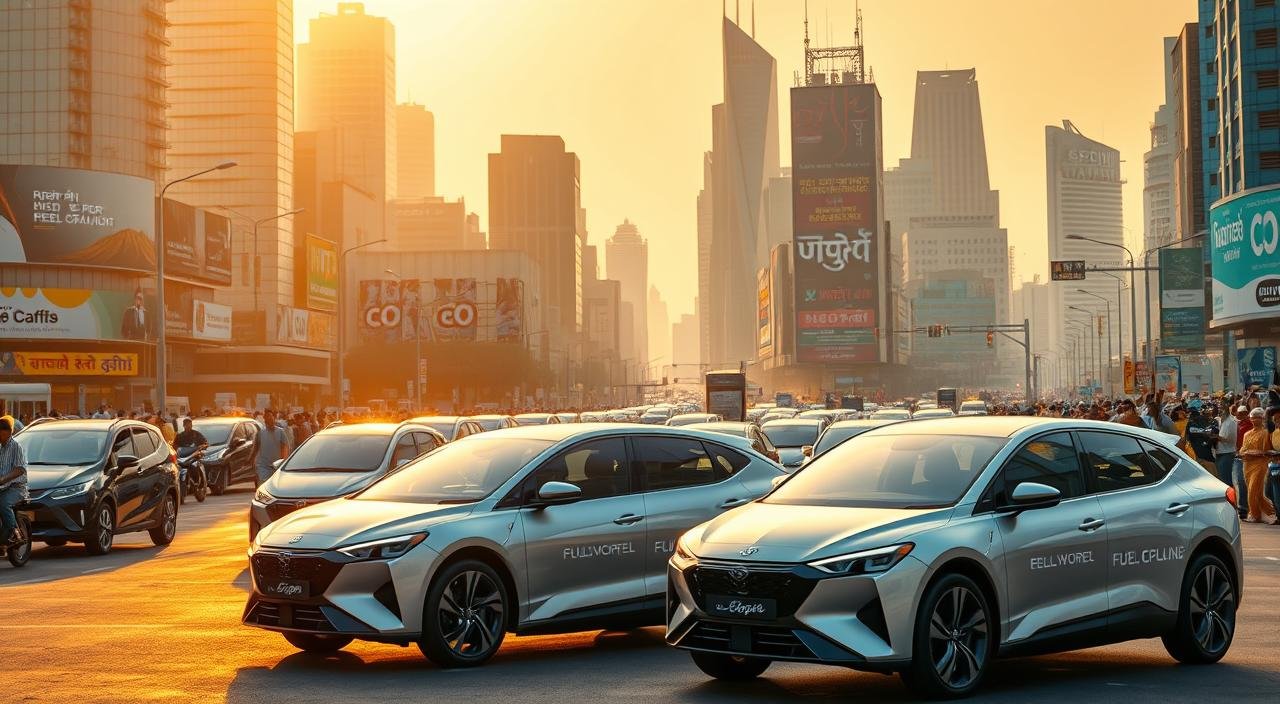
Oct
The Indian car market is on the verge of a big change. The government has announced a 5% GST rate for fuel-cell cars, starting September 22, 2025. This move puts hydrogen vehicles on the same level as petrol and diesel cars, changing the game.
Five key fuel-cell vehicles are set to hit the Indian market. Thanks to the lower GST rate, these cars will be more affordable for people looking for green options. This is a big win for those wanting to switch from traditional engines.
Now is the perfect time for this change. Global car makers are adding more fuel-cell models to their lines. With the 5% GST, fuel-cell cars in India can compete with traditional cars on price. This move shows India’s dedication to hydrogen technology in the car industry.
Key Takeaways
- India reduces GST on fuel-cell vehicles to 5%, matching rates for petrol and diesel cars
- Five hydrogen vehicles are prime candidates to launch in India following the tax benefit
- The policy takes effect September 22, 2025, making FCVs more affordable for buyers
- Fuel-cell cars now enjoy equal tax treatment with conventional vehicles for the first time
- Major automakers are preparing to introduce hydrogen models to capitalize on the incentive
- The GST reduction could accelerate India’s shift toward zero-emission transportation
Understanding Fuel-Cell Technology
Fuel-cell technology is a big step forward in cars, making them cleaner and more efficient. In India, people are looking for better ways to travel than old gas engines. FCVs are a top choice because they use hydrogen to make electricity, leading the way in green cars.
What Are Fuel-Cell Vehicles (FCVs)?
FCVs run on hydrogen fuel cells, making electricity from hydrogen and oxygen. They don’t burn gas like regular cars, so they only make water vapor and heat. This means no big batteries are needed, unlike electric cars.
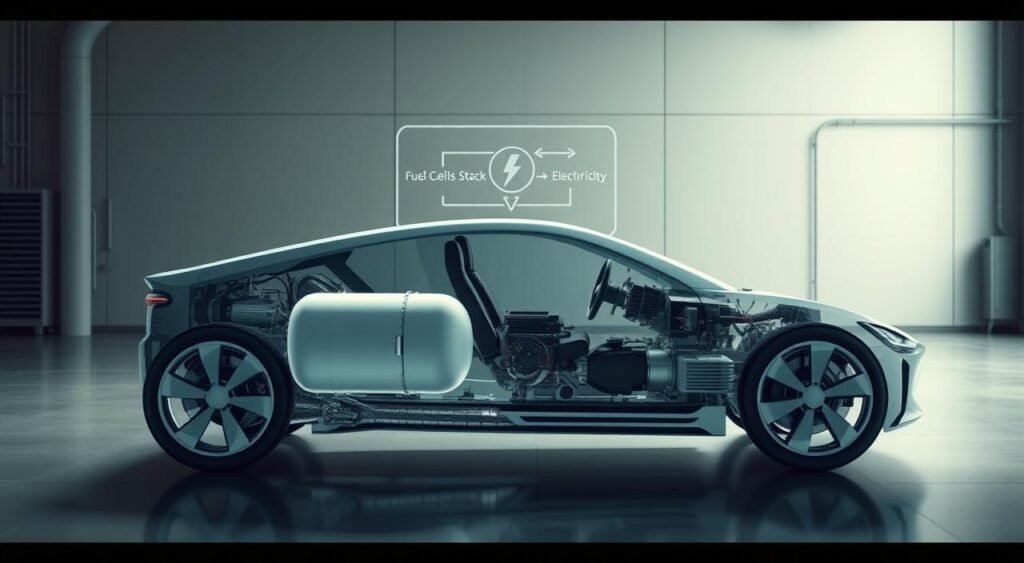
How Do Fuel Cells Work?
Fuel cells work by breaking down hydrogen into protons and electrons. The electrons make electricity for the car’s motor. Oxygen and the protons make water vapor, the only thing these cars emit.
Key Benefits of Fuel-Cell Technology
Hydrogen cars have many good points:
- Rapid refueling: Fill up in just 3-5 minutes, like gas cars
- Extended range: Go 400-600 kilometers on one tank
- Zero emissions: Only make water vapor
- Energy efficiency: Use 60% of fuel energy for power
- Quiet operation: Make very little noise
| Feature | FCVs | Traditional Vehicles |
|---|---|---|
| Refueling Time | 3-5 minutes | 5-7 minutes |
| Emissions | Water vapor only | CO2, NOx, particulates |
| Energy Efficiency | 60% | 20-35% |
| Range per Tank | 400-600 km | 500-800 km |
The Current State of Fuel-Cell Cars in India
The Indian car market is changing, moving from old engines to new, cleaner ones. Electric cars are getting popular, but fuel-cell cars are also gaining attention. The car industry in India, worth over $100 billion, is looking into hydrogen cars as a green option.
Overview of the Indian Automobile Market
India has a huge car market, with over 3.8 million cars sold every year. Big names like Toyota, Hyundai, and Tata Motors lead the market. Toyota, for example, has 12 models, but no fuel-cell cars yet.
People are starting to want cleaner cars because of pollution and bad air in cities. This interest could help fuel-cell cars become more common in India.

Government Policies Supporting FCVs
The government is backing hydrogen cars with new rules. They want to make fuel-cell cars cheaper to buy. In 2022, the government started a program with Toyota to test hydrogen cars.
Some key policies include:
- A new plan to make more green hydrogen
- Help for companies making fuel-cell cars
- Money for building hydrogen stations
- Tests in some cities to see how well they work
Challenges Facing FCV Adoption in India
Fuel-cell cars in India face big challenges. The biggest one is the lack of places to fill up with hydrogen. Hydrogen stations need special equipment and safety measures.
Other problems are the high cost of these cars, not many people know about them, and electric cars are also popular. The car industry, government, and others need to work together to make hydrogen cars a reality in India.
Financial Implications of GST on Fuel-Cell Vehicles
The introduction of a 5% GST rate for fuel-cell vehicles is a big deal for India’s car market. This lower tax makes these eco-friendly cars more affordable than regular cars. It means buyers can get advanced hydrogen technology at a better price.
What is GST and How Does It Work?
Goods and Services Tax (GST) is India’s single tax system that replaced old taxes. For cars, GST rates change based on the car’s type and features. Most cars face a GST rate between 18% and 28%, with extra taxes making it even higher.
The 5% GST for fuel-cell vehicles is the lowest tax for cars in India. This lower tax is a big help for these cars, which are good for the environment. It encourages more people to buy them.
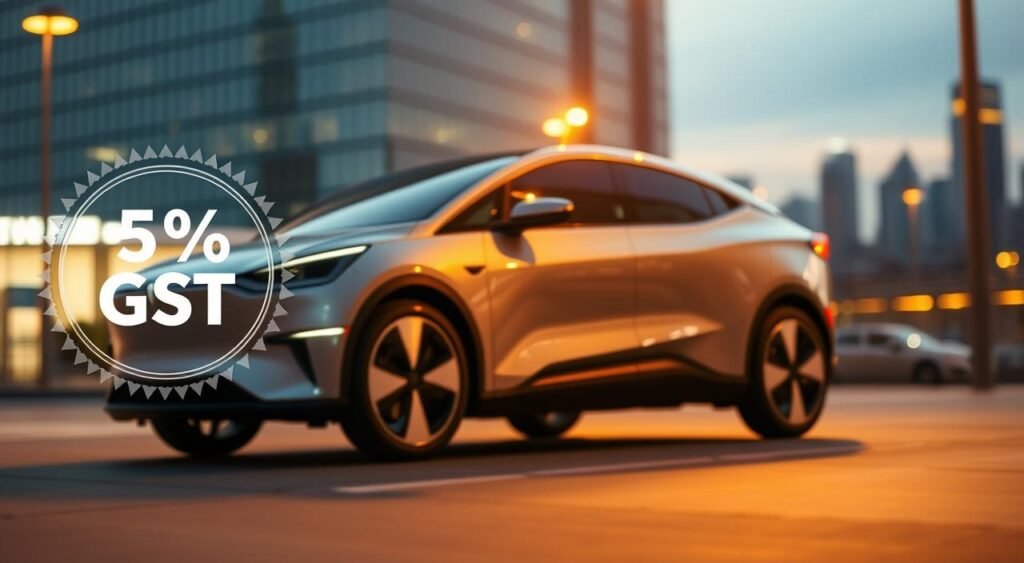
Impact of 5% GST on FCV Pricing
The lower GST rate saves a lot of money for buyers. For example, a fuel-cell car priced at Rs. 60 lakh gets a GST of just Rs. 3 lakh. This is much less than the taxes on regular luxury cars.
Comparisons with Other Vehicle Categories
| Vehicle Category | GST Rate | Additional Cess | Total Tax Impact |
|---|---|---|---|
| Fuel-Cell Vehicles | 5% | 0% | 5% |
| Electric Vehicles | 5% | 0% | 5% |
| Petrol/Diesel Cars | 28% | 1-20% | 29-48% |
| Hybrid Vehicles | 28% | 15% | 43% |
Fuel-cell vehicles now have the same tax benefits as electric vehicles. This makes them the most affordable eco-friendly cars to buy. They also get extra state incentives and lower fees in many places.
Five Fuel-Cell Vehicles Emerging in India
India’s car market is changing fast. Big names are getting ready to bring hydrogen cars to the roads. These cars use new tech that could change how we travel. Let’s look at the top FCVs that might get cheaper soon.
Toyota Mirai: A Trailblazer in FCVs
The Toyota Mirai is a leader in hydrogen cars worldwide. It’s a sleek sedan with over 180 PS power. It can go 600-650 kilometers on one tank, making long trips easy.
What’s cool about the Mirai is how fast it refuels. Just five minutes to fill up. It’s been improved over the years, making it even better.
Hyundai Nexo: An Innovative Approach
Hyundai’s Nexo is a mid-size SUV, like the Tucson. It goes over 700 kilometers on a single tank. It also refuels quickly, in just five minutes.
This SUV is great for families. It’s big and has the latest fuel-cell tech. It’s a top choice for those wanting a big, green car.
Honda Clarity: Features and Benefits
Honda’s CR-V FCEV is different. It has a hydrogen fuel cell and a 17.7 kWh battery. This combo gives it a 450-kilometer range.
It’s special because you can use electric power too. This makes it very versatile, unlike most FCVs.
Tata Motors’ Future Projections
While big brands lead, Tata Motors is also working on hydrogen cars. They see the value of fuel cells for India. They’re making cars that fit India’s needs and infrastructure.
How 5% GST Could Boost FCV Sales
The introduction of a 5% GST rate for fuel-cell cars in India is a big deal. It makes fuel-cell cars more affordable for both makers and buyers. This could change the game for clean energy vehicles in the market.
Potential for Increased Adoption Rates
The 5% GST rate lowers the cost of fuel-cell cars in India. This makes them more appealing to a wider range of people. Electric vehicles, on the other hand, face GST rates between 12% to 28%.
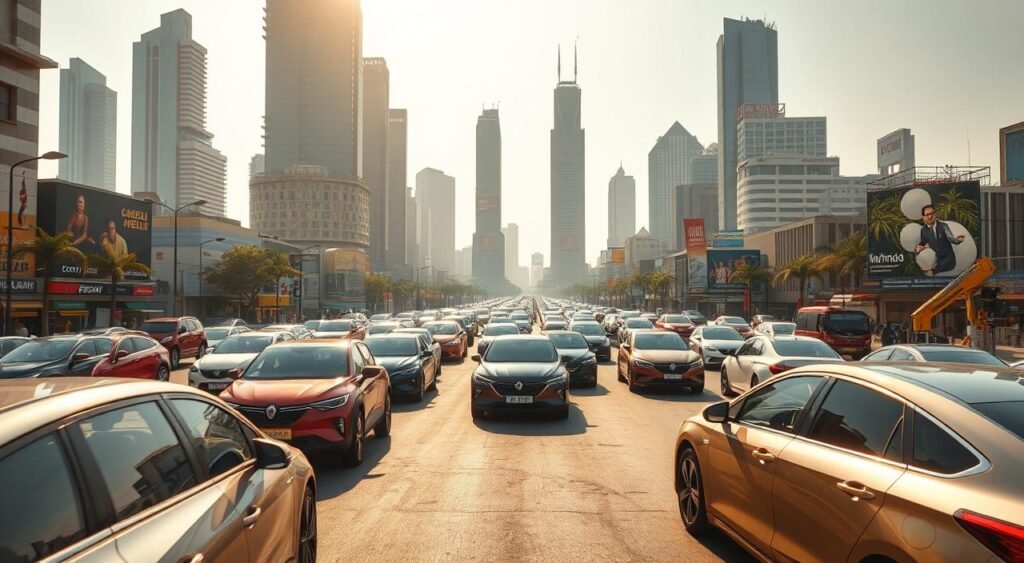
Lower taxes could lead to a 30-40% increase in FCV adoption in the first two years. Fleet operators and corporate buyers are interested in FCVs. They like the quick refueling and longer driving ranges compared to electric cars.
Encouragement for Manufacturers and Investors
The reduced GST rate shows India’s commitment to hydrogen technology. Big names like Toyota and Hyundai are thinking about bringing their hydrogen models to India. The tax benefits make it easier to produce and sell these cars locally, attracting more investment.
Consumer Awareness and Education
For FCVs to succeed, people need to understand their benefits. Zero tailpipe emissions, fast refueling, and long driving ranges are key. Industry groups and the government are working on campaigns to spread the word about these advantages and the 5% GST rate.
Environmental Impact of Fuel-Cell Vehicles
Fuel-cell vehicles are a big step forward in clean energy cars. They help India move towards a greener future. Unlike gas cars, FCVs only release water vapor, not harmful pollutants.
This is great news for India’s air quality and its environmental goals.
Reducing Carbon Emissions
Fuel-cell vehicles don’t have tailpipe emissions, making them eco-friendly cars. Each FCV can cut down about 4.6 metric tons of CO2 a year. This is a big deal for cities like Delhi and Mumbai, which are really struggling with air pollution.
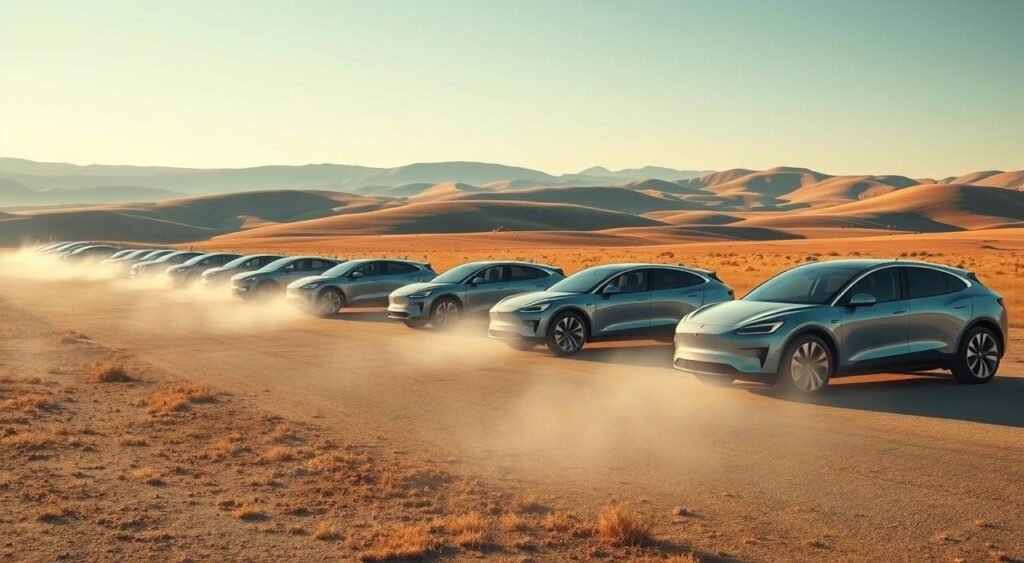
The Role of Renewable Energy in FCVs
The good news about green vehicles goes beyond zero emissions. If hydrogen is made from solar or wind power, FCVs are totally carbon-neutral. India’s growing solar farms in places like Rajasthan and Gujarat are perfect for making clean hydrogen.
Long-term Sustainability Benefits
FCVs have big advantages over electric cars in how they affect the environment. They don’t have the lithium mining and battery disposal issues. They also need fewer rare earth materials and last longer.
As India builds its hydrogen network, these clean energy cars will be key to reaching its 2070 net-zero emissions goal.
FCVs vs. Battery Electric Vehicles (BEVs)
The Indian car market is at a turning point. It’s between fuel-cell vehicles and battery electric vehicles. Each has its own benefits for those who care about the environment. Knowing the differences helps people choose the right car for them.
Comparing Performance and Efficiency
Fuel-cell vehicles are quick to refuel, taking only 3-5 minutes. This is much faster than charging electric cars, which can take hours. They also have a long range, up to 820 kilometers per tank, beating many electric cars.
Battery electric vehicles are better at using energy, turning 77% of it into power. Fuel-cell cars are about 60% efficient. Both types don’t emit any pollution, making them good choices for clean energy.
Cost Considerations and Long-term Value
There’s a big price difference at the start:
| Vehicle Type | Average Price Range (INR) | Fuel Cost per 100km | Maintenance Frequency |
|---|---|---|---|
| Fuel-Cell Vehicles | 50-65 lakhs | ₹400-500 | Every 10,000 km |
| Battery Electric Vehicles | 15-35 lakhs | ₹80-150 | Every 15,000 km |
BEVs are cheaper to run, which appeals to those watching their budget. Fuel-cell cars need less battery replacement, which could save money in the long run, even if they cost more upfront.
Infrastructure Needs for Both Technologies
Building more charging stations is key for both types. India had over 1 million EV charging points by 2019. But, hydrogen cars have fewer places to refuel.
Setting up hydrogen stations is expensive, costing ₹15-20 crores each. EV charging is easier to expand, with many people able to charge at home. Both need more stations to become more popular in India.
The Role of Government in Promoting FCVs
The government is key in shaping the future of fuel-cell cars in India. They are making policies and partnerships to help hydrogen cars grow. The 5% GST rate is a big step towards making cars more affordable and sustainable.
Incentives for Consumers and Businesses
The Indian car industry is getting a lot of support from the government. The 5% GST rate makes fuel-cell cars cheaper than regular cars. This can save people around ₹5-10 lakhs on high-end FCVs.
- Direct purchase subsidies under the FAME scheme
- Tax deductions for businesses adopting hydrogen fleets
- Reduced road tax and registration fees in select states
- Priority parking and toll exemptions for FCV owners
Collaborations with Automotive Manufacturers
Partnerships between the government and car makers are speeding up FCV development. The 2022 pilot program with Union Minister Nitin Gadkari testing the Toyota Mirai was a big moment. These partnerships include research and technology sharing with Toyota and Hyundai.
Future Policy Directions
The future plans include building more hydrogen stations and growing the market. They aim to have 100 stations by 2030 in big cities. The goal is to use green hydrogen made from renewable energy, making cars run on clean energy.
Policy frameworks are being drafted to standardize hydrogen fuel quality and safety protocols, creating a strong ecosystem for the industry’s future.
Public Perception and Acceptance of FCVs
In India, understanding hydrogen vehicles is a big challenge. Many people don’t know how FCVs work or their benefits. We need to clearly explain how they work and address concerns to gain trust.
Common Misconceptions About Fuel-Cell Technology
Many myths about FCVs slow their adoption. Some think they’re dangerous because of fuel storage. But, modern hydrogen tanks are tested and safe.
Another myth is that they can’t go far. The Toyota Mirai can go over 400 miles on one tank, just like gas cars. High costs are also a worry. But, running them is cheaper, and refueling is quick.
Japan and South Korea have shown FCVs are reliable. But, many in India don’t know this.
Educational Initiatives for Consumers
Car makers and governments are working to teach people about FCVs. They offer test drives and share info online. They also train dealers and service centers.
Success Stories from Early Adopters
The 2022 Toyota Mirai pilot in New Delhi was a success. Fleet operators were happy with the cars’ performance. Programs in California and Germany offer lessons for India.
Companies using hydrogen vehicles save money and help the environment. This encourages more people to accept them.
The Future of Fuel-Cell Cars in India
India is at a turning point with fuel-cell cars set to change its car scene. A 5% GST cut opens doors for eco-friendly cars to enter the market. Big names like Toyota and Hyundai are getting ready to launch their fuel-cell models. Tata Motors, a local company, is also diving into this exciting tech.
But, there’s a lot of work ahead. We need to plan well and invest in hydrogen infrastructure.
Predictions for Market Growth
Experts think fuel-cell cars in India will grow slowly but surely over the next ten years. The Toyota Mirai and Hyundai Nexo are set to be the first ones on the market. BMW’s iX5 Hydrogen and Honda’s CR-V FCEV are also waiting for the right time to come out.
They predict that by 2030, hydrogen cars could grab 2-3% of the premium car market. This will happen if we have more hydrogen stations and teach people about fuel-cell tech.
Technological Advances on the Horizon
New tech in fuel cells promises better efficiency and lower costs. Engineers are working on better hydrogen storage and using less platinum in fuel cells. The Toyota Crown shows off advanced fuel-cell tech that might come to India.
Improvements in battery tech are also helping fuel cells. They’re making hybrid systems that use both power sources. These changes make eco-friendly cars more suitable for Indian roads and driving habits.
Closing Thoughts on the Importance of FCVs in India
Fuel-cell vehicles are key for India’s clean transport future. The GST cut shows the government’s support for green vehicles, not just battery electric ones. Success needs teamwork between car makers, energy firms, and government to build hydrogen stations.
The path to making fuel-cell cars common in India is long. But, the steps we take today will shape tomorrow’s transport. As India seeks energy freedom and cleaner air, fuel-cell cars are a vital option that deserves our support.
FAQ
What is the new GST rate for fuel-cell vehicles in India?
The GST rate for fuel-cell vehicles in India has been cut to 5%. This change took effect on September 22, 2025. It makes FCVs more affordable, putting them in a better tax position than traditional vehicles.
How do hydrogen vehicles differ from battery electric vehicles?
Hydrogen vehicles use hydrogen as fuel and can refuel quickly, like regular cars. Battery electric vehicles take longer to charge. FCVs have long driving ranges and zero tailpipe emissions, making them eco-friendly and convenient.
Which fuel-cell cars could launch in the Indian automotive industry?
Five FCVs might soon hit the Indian market. These include the Toyota Mirai, Hyundai Nexo, Honda CR-V FCEV, BMW iX5 Hydrogen, and Toyota Crown. They offer various styles and power, from 180 PS to over 400 PS.
What are the main challenges facing clean energy cars adoption in India?
The biggest hurdle is the lack of hydrogen refueling stations. India has many EV charging points but few for hydrogen. Despite government support, building more stations is key for wider adoption.
What are the environmental benefits of green vehicles like FCVs?
FCVs emit no tailpipe emissions, making them better for the environment than traditional cars. They use hydrogen instead of lithium-ion batteries, reducing environmental impact. This supports India’s goal for cleaner energy and lower carbon emissions.
How does the 5% GST benefit compare to other eco-friendly cars?
The 5% GST rate makes FCVs cheaper for buyers. This tax advantage makes premium FCVs like the Toyota Mirai more competitive in India. It’s a big plus compared to cars with higher GST rates.
What role has the government played in promoting fuel-cell cars in India?
The government has backed FCVs with a 5% GST rate and pilot programs. The 2022 Toyota Mirai study shows their commitment. But, more work is needed to improve infrastructure.
How long does it take to refuel a hydrogen vehicle?
Refueling hydrogen vehicles takes just 3-5 minutes, similar to traditional cars. This is a big plus over battery electric vehicles, which take hours to charge. It makes FCVs great for long trips and quick stops.
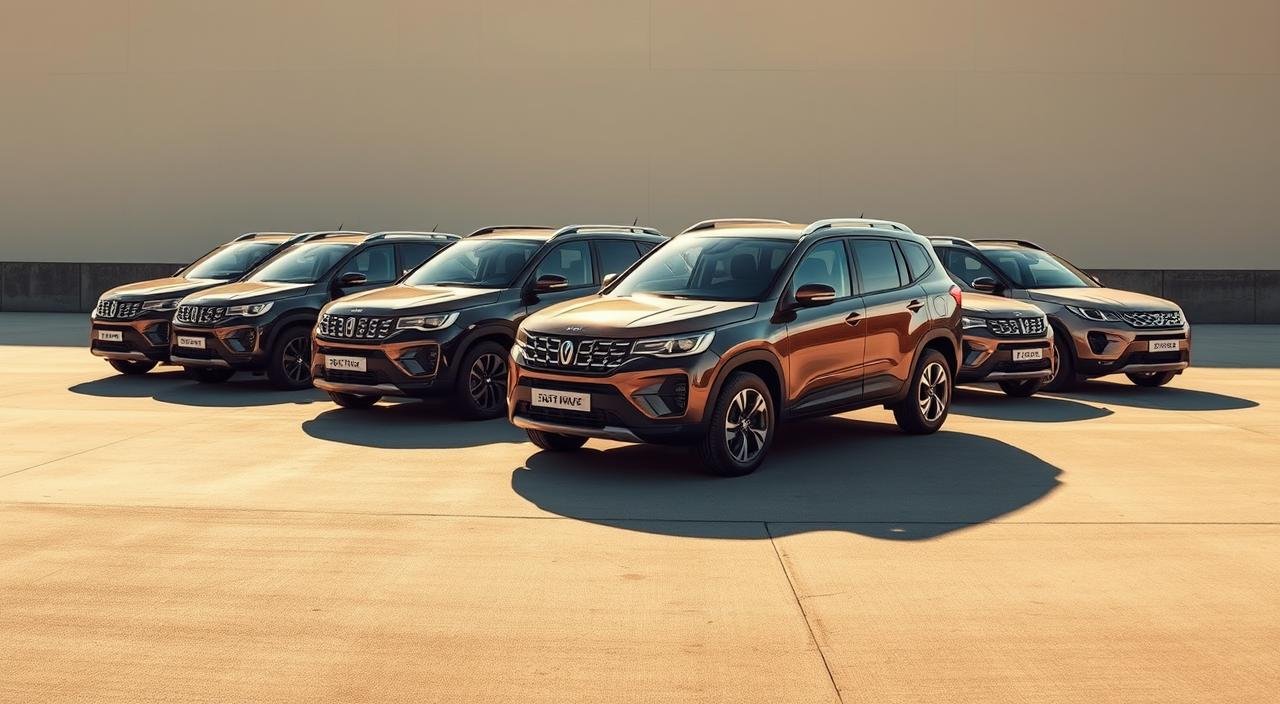
Jul
Why are diesel SUVs disappearing from showrooms when Indian buyers want fuel-efficient vehicles for long commutes?
Finding affordable diesel SUVs in India is tough now. But, some brands offer budget-friendly options with 1.5L engines. These cars are great for saving fuel and are priced well for middle-class families.
Today, there are five top diesel SUVs in India priced under Rs. 11 Lakh. The Mahindra XUV 3XO is the cheapest at Rs. 9.99 Lakh. Tata Nexon and Kia Sonet start at Rs. 10.00 Lakh. Hyundai Venue diesel starts at Rs. 10.80 Lakh. Each car has a 1.5L diesel engine that gets between 17 to 24 kmpl.
These Top 5 Budget Diesel SUVs in India are smart choices for those looking for affordable daily drives. They offer great fuel efficiency, affordable prices, and useful features. These make them perfect for Indian roads and driving habits.
Key Takeaways
- Budget diesel SUVs are available, even though the industry is moving to petrol engines
- All featured models use efficient 1.5L diesel engines for better fuel economy
- Prices start from Rs. 9.99 Lakh for the most affordable diesel variants
- Fuel efficiency ranges from 17-24 kmpl across different models
- Mahindra XUV 3XO is the most affordable option
- These diesel SUVs help save a lot on fuel costs over time
Introduction to Budget Diesel SUVs in India
The Indian car market loves diesel SUVs. Affordable Diesel SUVs are popular for being fuel-efficient and powerful. They offer great value for money. With 57 diesel models available, prices range from Rs. 8.99 Lakh to Rs. 1.35 Crore.
Understanding Diesel Engines and Their Appeal
Diesel engines are popular in India for good reasons. They have more torque at lower RPMs, perfect for city and highway driving. Diesel SUVs with 1.5L Engines are a great mix of power and fuel efficiency, saving up to 25% fuel compared to petrol.
Diesel engines are not just about saving fuel. They have strong pulling power, great for heavy loads and tough terrains. They are also long-lasting, making them a reliable choice for Indian buyers.
Current Trends in the Indian Auto Market
Recent data shows what people want in cars. The Jeep Compass, Mahindra Scorpio N, and Hyundai Creta are top picks for diesel SUVs. Mahindra leads with models like the XUV 3XO, Scorpio N, and XUV700.
Even as electric and petrol cars gain fans, diesel SUVs remain popular. Their cost-effectiveness and performance meet Indian driving needs well.
Importance of Fuel Efficiency in SUVs
Fuel efficiency is key when picking an SUV in India’s market. With fuel prices going up and daily drives, people look for cars that go far on a liter. Affordable Diesel SUVs in India are popular for their great fuel economy. They are good for those who want to save money but don’t want to give up on space or comfort.
How Diesel Engines Offer Better Mileage
Diesel engines work differently than petrol ones. They use compression to ignite fuel, leading to better efficiency. This means SUV owners get more miles per liter. The Top 5 Diesel SUVs show off their fuel-saving skills:
- Tata Nexon diesel variants achieve up to 24.08 kmpl
- Hyundai Creta diesel models deliver between 17.4-21.8 kmpl
- Mahindra XUV 3XO provides 17-21 kmpl
- Kia Seltos diesel offers 17-20.7 kmpl

Cost Savings Over Time with Diesel SUV Ownership
Choosing Affordable Diesel SUVs in India saves money over time. They are great for long trips. Many Hyundai Creta diesel owners say they can drive 300 kilometers without needing to stop for fuel.
This means they don’t have to stop as often. It also saves money on gas. These cars are perfect for those who travel a lot and want to save money.
Criteria for Selecting Budget Diesel SUVs
Choosing the right diesel SUV is important. Budget Diesel SUVs in India are great value if you know what to look for. Knowing the price range and key features helps you pick from the many Top Diesel SUV Models out there.
Price Range Definition for Budget Models
Budget Diesel SUVs cost between Rs. 9.99 Lakh and Rs. 12 Lakh ex-showroom. This makes them affordable for middle-class families looking for fuel-efficient cars. In this price range, you can find well-equipped models from well-known brands.
Key Features to Look For
When looking at Top Diesel SUV Models, some features are more important than others. Safety equipment is the most critical, followed by fuel efficiency and modern features.
| Feature Category | Essential Requirements | Expected Standards |
|---|---|---|
| Engine Specifications | 1500cc displacement | 17+ kmpl mileage |
| Safety Features | Dual airbags, ABS with EBD | Electronic stability control |
| Convenience Features | Touchscreen infotainment | Apple CarPlay/Android Auto |
| Transmission Options | Manual availability | Automatic variants |
| Additional Equipment | Rear parking sensors | Cruise control |
Smart buyers look for models with both manual and automatic transmissions. Five-seater configurations are common, providing enough space for families. Modern connectivity features improve the driving experience without adding too much cost.
Mahindra XUV300: A Value for Money Proposition
The Mahindra XUV300 is a top pick for those looking for Diesel SUVs in India on a budget. It starts at Rs. 9.99 Lakh ex-showroom. This compact SUV offers great value with its performance, safety, and features.
It’s a strong contender in the Best Budget Diesel SUVs category. It balances practicality with modern amenities well.

Engine Performance and Specifications
The XUV300 has a 1493cc diesel engine. It offers strong performance and good fuel efficiency, between 17-21 kmpl. You can choose from manual and automatic transmissions.
This engine is smooth and responsive. It’s great for city driving and long highway trips.
Safety Features and Ratings
Safety is a big deal in the XUV300. It comes with 6 airbags in all variants. It also has:
- 360-degree camera system for better visibility
- ABS with EBD for safe braking
- Electronic Brake Assist (EBA) for emergencies
- Auto-dimming rear-view mirror to cut down glare
- Central locking and engine immobilizer
- Child safety locks on rear doors
These safety features make the XUV300 one of the safest Diesel SUVs in India for its price. People love its driving and build quality. It’s a smart choice for families looking for safe, affordable cars.
Tata Nexon: The Compact SUV with Style
The Tata Nexon is a standout in the affordable diesel SUV market. It boasts a bold design and modern features. Starting at Rs. 10.00 Lakh for diesel models, it offers premium features at a budget-friendly price.
Design Characteristics That Stand Out
The Nexon’s design is unlike any other SUV. Its humanity line creates a unique look. The projector headlamps and 16-inch alloy wheels make it look premium.
The interior is modern and well-designed. It feels luxurious, even at its price.
Technology and Connectivity Features
The Nexon is packed with tech for its price. It has:
- 7-inch touchscreen with Apple CarPlay and Android Auto
- Digital instrument cluster
- Rain-sensing wipers and automatic climate control
- Ventilated front seats and air purifier
- 360-degree camera with parking assistance
- Cruise control
It also focuses on safety with 6 airbags and advanced features. This makes it a top choice without breaking the bank.
Hyundai Venue: A Popular Choice Among Consumers
The Hyundai Venue is a top pick for many with its starting price of Rs. 10.80 Lakh ex-showroom. It’s a compact SUV that combines practicality and affordability. Its diesel engine is fuel-efficient and powerful, meeting the needs of diesel SUVs with 1.5L engines.
Engine Performance and Variants Availability
The Venue’s diesel engine is perfect for city driving and long trips. You can choose from manual or automatic transmissions. This makes it great for different driving styles. It’s a strong competitor in the budget segment, like the Kia Sonet.
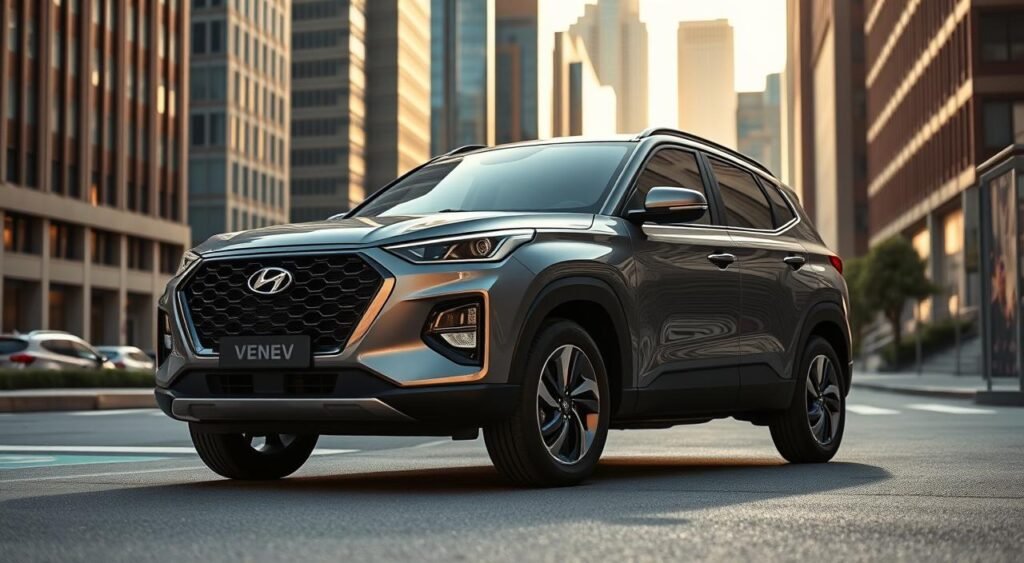
Comfort and Interior Quality
The interior of the Venue feels luxurious, even at its price. It’s roomy, with enough space for five people. You’ll find features like:
- Modern infotainment system with smartphone connectivity
- Automatic climate control
- Multiple safety features including airbags and ABS
- Rear parking sensors and camera
Hyundai’s wide service network in India makes owning a Venue easy. It’s a top choice for those looking for a good balance of features, performance, and price in diesel SUVs with 1.5L engines.
Ford EcoSport: Embracing a Classic Design
The Ford EcoSport is a top pick among Budget Diesel SUVs. It has a trusted design and useful features. This compact SUV is reliable and practical for those looking for Affordable Diesel SUVs in India. Its classic look is perfect for those who like traditional designs over modern ones.
Engine Details and Performance Insights
The EcoSport’s diesel engine is a 1.5-liter TDCi. It offers good performance for both city and highway driving. It has 100 PS of power and 215 Nm of torque, and it only has a 5-speed manual transmission. This engine helps the SUV accelerate smoothly and handle well when passing.
The EcoSport gets about 21.7 kmpl, which is good for its class. The engine is quiet, and the throttle is easy to use in the city.
Practicality and Cargo Space
The EcoSport is great for daily use with its smart interior design. It has 352 liters of boot space, which grows when the rear seats are folded. Its 200mm ground clearance handles rough roads well.
| Feature | Specification |
|---|---|
| Boot Capacity | 352 liters |
| Ground Clearance | 200mm |
| Fuel Tank | 52 liters |
| Seating Capacity | 5 passengers |
The EcoSport has lots of storage spots for daily items. The spare wheel on the tailgate adds to its rugged look without losing cargo space. These features make the EcoSport a great choice for families looking for Affordable Diesel SUVs in India under Rs. 12 Lakh.
Kia Sonet: Features Packed into a Budget SUV
The Kia Sonet is a top pick for those looking for a budget-friendly diesel SUV. It starts at Rs. 10.00 Lakh for diesel models. This compact SUV offers premium features at an affordable price, making it perfect for those who want modern tech and efficient performance without breaking the bank.

Overview of the Engine Options
The Sonet’s diesel engines are designed for budget-conscious drivers. The 1.5-liter CRDi diesel engine packs 115 PS of power and 250 Nm of torque. This makes it great for both city and highway driving.
There are two transmission options: a 6-speed manual and a 6-speed automatic. This allows buyers to choose what suits their driving style best.
| Engine Type | Power Output | Torque | Transmission Options |
|---|---|---|---|
| 1.5L CRDi Diesel | 115 PS | 250 Nm | 6-Speed MT/6-Speed AT |
User-Friendly Technology and Infotainment
The Sonet leads in bringing the latest tech to the Top 5 Diesel SUVs. Its highlight is a 10.25-inch touchscreen infotainment system. It supports wireless Android Auto and Apple CarPlay.
The SUV also comes with UVO Connect technology. This offers over 50 connected car features, voice commands, and remote vehicle control through smartphone apps. It also has automatic climate control, wireless phone charging, and ambient mood lighting. These features make the Sonet a hit with tech-savvy buyers in the compact SUV market.
Comparison of the Top 5 SUVs
Choosing a diesel SUV in India means looking at specs, price, and features. The top 5 budget diesel SUVs with 1.5L engines have their own benefits. Prices range from Rs. 9.99 lakh to Rs. 10.80 lakh, making them good for those watching their budget but wanting diesel’s efficiency.
Key Specs and Features Side by Side
Each model is a 5-seater with manual and automatic options. The Mahindra XUV3XO is the cheapest at Rs. 9.99 lakh, with a 1493cc engine. The Tata Nexon and Kia Sonet start at Rs. 10.00 lakh, with engines of similar size. The Hyundai Venue is pricier at Rs. 10.80 lakh but offers automatic options.
| Model | Starting Price | Engine Size | Safety Features |
|---|---|---|---|
| Mahindra XUV3XO | Rs. 9.99 Lakh | 1493cc | 6 Airbags |
| Tata Nexon | Rs. 10.00 Lakh | 1497cc | 6 Airbags |
| Hyundai Venue | Rs. 10.80 Lakh | 1497cc | 6 Airbags |
| Kia Sonet | Rs. 10.00 Lakh | 1493cc | 6 Airbags |
Fuel Efficiency Ratings of Each Model
Fuel efficiency is key for diesel SUVs in India. The Tata Nexon leads with 17.01-24.08 kmpl in various conditions. The Mahindra XUV3XO comes next with 17-21 kmpl. The Hyundai Venue and Kia Sonet also offer good mileage for daily use. These SUVs are great for both long trips and city driving.
Pros and Cons of Owning a Diesel SUV
Choosing between diesel and petrol SUVs needs careful thought. Affordable Diesel SUVs are popular for their fuel efficiency and comfort on long drives. Knowing the pros and cons helps you decide what’s best for you.
Advantages of Diesel Engines in SUVs
Diesel SUVs with 1.5L Engines save a lot on fuel, which cuts down costs. They can go up to 24 kilometers per liter, perfect for daily and long trips. Their strong torque makes driving smooth and easy.

- Lower fuel costs for high-mileage drivers
- Better pulling power for loaded vehicles
- Quieter engine operation at cruising speeds
- Longer intervals between fuel stops
Potential Drawbacks and Maintenance Considerations
Despite their benefits, Affordable Diesel SUVs have some downsides. They cost more than petrol models by 1-2 lakhs. Also, maintenance can be pricier because of parts like turbochargers and filters.
Important things to think about include:
- Regular service schedules must be strictly followed
- Quality diesel fuel and engine oil are essential
- Limited model availability as manufacturers shift focus
- Higher repair costs for engine components
Diesel SUVs with 1.5L Engines are good for those who drive over 1,500 kilometers a month. The fuel savings can make up for the higher maintenance costs in 3-4 years.
Final Thoughts on Budget Diesel SUVs in India
The Indian car market is changing, with more focus on petrol and electric cars. But, diesel SUVs are popular among those who want to save money and get good fuel mileage. There are many great options under Rs. 12 lakh from brands like Mahindra, Tata, Hyundai, and Kia.
Future of Diesel Vehicles in the Indian Market
Diesel cars are getting cleaner, meeting new emission standards. Soon, we’ll see new Top Diesel SUV Models in the market. Maruti is working on the Escudo with diesel options, and Tata is reviving the Sierra. Renault’s new Duster will also have diesel choices in 2025-2026.
Recommendations for Future Buyers
When buying a diesel SUV, think about how you drive. Consider these points when choosing from Best Budget Diesel SUVs:
- How far you drive each day and if you use highways a lot
- The total cost of owning the car, including insurance and upkeep
- If there are service centers near you
- The warranty offered by the car’s maker
- The car’s value when you sell it
If you’re looking to save money, act fast. Diesel SUVs offer great fuel efficiency, power, and value for the money. They’re a smart choice for Indian roads and fuel prices.
Conclusion: Choosing the Right Diesel SUV for Your Needs
The Indian car market has many good diesel SUVs for those who want fuel savings and value. Each model has its own strengths, fitting different driving needs and lifestyles. It’s important to know what you need for your daily drive.
Recap of the Top Models Discussed
The top 5 budget diesel SUVs with 1.5L engines each have their own benefits. The Mahindra XUV300 starts at Rs. 9.99 Lakh and offers great value with its strong build. The Tata Nexon, priced from Rs. 10.00 Lakh, is a fuel efficiency leader with modern looks.
The Hyundai Venue starts at Rs. 10.80 Lakh, giving a smooth ride and a premium feel inside. The Kia Sonet also starts at Rs. 10.00 Lakh, packed with tech features. The Ford EcoSport is a classic SUV choice.
Encouragement to Consider Personal Requirements
Choosing a budget diesel SUV needs careful thought about your needs. Think about your daily drive, family size, and what features you want. If you travel long distances, the Nexon’s fuel efficiency is key.
For families, the XUV300’s roomy interior is a plus. Tech lovers will like the Sonet’s connectivity. City drivers might prefer the Venue’s size and handling. These 1.5L diesel engines are some of the last chances for efficient diesel cars as India moves to new fuels.
FAQ
What are the most affordable diesel SUVs currently available in India?
In India, the cheapest diesel SUVs are the Mahindra XUV 3XO at Rs. 9.99 Lakh, Tata Nexon at Rs. 10.00 Lakh, Kia Sonet at Rs. 10.00 Lakh, and Hyundai Venue at Rs. 10.80 Lakh. These models have efficient 1.5L diesel engines. They are the top picks for those looking for a budget-friendly diesel SUV.
Which budget diesel SUV offers the best fuel efficiency?
The Tata Nexon is the leader in fuel efficiency, with up to 24.08 kmpl. The Mahindra XUV 3XO, Hyundai Creta, and Kia Seltos also offer great mileage. These SUVs are great for those who drive a lot.
What are the key advantages of buying a diesel SUV over a petrol variant?
Diesel SUVs are better because they use less fuel, up to 24 kmpl. They also have more power for long drives. This makes them cheaper to run, perfect for those who travel a lot.
Which diesel SUV models are the most popular in India currently?
In India, the Jeep Compass, Mahindra Scorpio N, and Hyundai Creta are the top diesel SUVs. There are 57 diesel SUV models available, from Rs. 8.99 Lakh to Rs. 1.35 Crore. Mahindra leads with many budget-friendly options.
What safety features come standard in budget diesel SUVs?
Budget diesel SUVs have many safety features. The Mahindra XUV 3XO and Tata Nexon come with 6 airbags and advanced safety tech. They also have hill assist, TPMS, and electronic stability control.
Are there automatic transmission options available in budget diesel SUVs?
Yes, many budget diesel SUVs have automatic transmission. The Tata Nexon has a 6-speed AMT, and the Mahindra XUV 3XO and Hyundai Venue offer automatic options too. This makes driving easier without losing fuel efficiency.
What should buyers consider when choosing between these top diesel SUV models?
Buyers should think about their daily needs, total costs, and what features they want. The Mahindra XUV 3XO is a great value at Rs. 9.99 Lakh. The Tata Nexon is best for fuel, Hyundai Venue for smoothness, and Kia Sonet for features. Check the service network and warranty in your area too.
What is the future outlook for diesel SUVs in India?
Diesel SUVs are staying relevant in India, despite the trend towards petrol and electric. New models like the Maruti Escudo, Tata Sierra, and Renault Duster will come with diesel options in 2025-2026. Now is the time to buy a diesel SUV as they become less common.

May
Is the iconic Indian off-road vehicle, the Mahindra Thar soft-top convertible, truly reaching the end of its journey? Mahindra & Mahindra has surprised many by stopping production of the convertible Thar SUV. This change means the Thar lineup now only has fixed hardtop models.
The end of the Mahindra Thar soft-top convertible makes people wonder about open-roof SUVs in India. It was the only one made in the country. Its rugged look, off-road skills, and open-air feel made it a hit with adventure lovers.
Key Takeaways
- Mahindra & Mahindra discontinues soft-top convertible variants of the Thar SUV
- Thar lineup now exclusively features fixed hardtop models across all variants
- Decision reflects changing consumer preferences and automotive industry trends
- Thar soft-top convertible was the only factory-produced open-roof SUV in India
- Discontinuation raises questions about the future of convertible SUVs in the Indian market
The Mahindra Thar: A Brief Overview
The Mahindra Thar is a legendary off-road vehicle that stands out in automotive history. Its retro-styled design has won the hearts of many. It’s perfect for off-road adventures and daily driving.
Evolution of the Thar Model
The Thar’s design was inspired by the original Willys Jeep. Over time, it has evolved with better off-road skills and modern comforts. From the MM540 to today’s Thar, Mahindra has always aimed high.
Popular Features of the Thar
The Thar is known for its amazing off-road abilities. It has a strong chassis, high ground clearance, and advanced 4×4 systems. These features help it conquer tough terrains.
Inside, you’ll find modern tech and a rugged feel:
- Touchscreen infotainment system
- Cruise control
- Safety technologies like ABS and airbags
- Comfortable seating with weather-resistant upholstery

Market Position and Target Audience
The Mahindra Thar has a special place in the Indian car market. It attracts both serious off-road fans and those who love adventure. Its design and capabilities make it a dream car for many.
Whether you’re on a trail or driving on the highway, the Thar offers a unique ride. Its mix of classic looks, modern tech, and off-road skills makes it a true SUV icon.
Reasons Behind the Discontinuation
The decision to stop making the Mahindra Thar soft-top convertible has sparked debate. This move has puzzled fans and industry watchers. The Thar was known for its adventure and off-road skills. Yet, several reasons led to Mahindra’s change in its lineup.

Consumer tastes have shifted towards more practical SUVs. Hardtop SUVs are now in high demand. People want better protection, less noise, and more security features. The soft-top convertible, though iconic, struggled to meet these new needs.
Safety Regulations Impacting Design
Stricter safety rules also played a part. Emission and crash safety standards have tightened. The Thar’s soft-top design might not have met these new rules. This made Mahindra look for other ways to meet these standards.
Production Cost and Profitability Concerns
Business considerations also weighed in. Making a unique product like the SUV convertible costs more. It needs special parts and can’t benefit from large-scale production. Mahindra wanted to make its products more profitable. So, it decided to stop making the soft-top version.
Implications for Off-Road Enthuisiasts
The Mahindra Thar soft-top convertible’s end has big news for off-road vehicle enthusiasts. They miss the open-air joy it brought. Many fans and owners are sad to see this special version go.

Even though the soft-top Thar is gone, fans can keep the dream alive. The aftermarket world is ready with soft-top kits and parts. This lets owners keep their Thars open and unique.
Shift to Hard-Top Models
Now, off-road vehicle enthusiasts must switch to hard-top Thars. The hard-top is better for weather and safety. But, some might miss the soft-top’s freedom and ease.
Availability of Aftermarket Soft-Top Options
The aftermarket is stepping up to replace the factory soft-top Thar. Many trusted brands will offer soft-top kits. This way, Thar owners can get back their nostalgic driving experience.
| Aftermarket Soft-Top Provider | Estimated Price Range | Features |
|---|---|---|
| Off-Road Accessories Inc. | Rs. 50,000 – 75,000 | High-quality materials, easy installation |
| Thar Customs Ltd. | Rs. 60,000 – 80,000 | Durable construction, multiple color options |
| Adventure Gear Co. | Rs. 55,000 – 70,000 | Weatherproof design, quick-release mechanism |
Community Reactions and Sentiment
The Thar community has mixed feelings about the soft-top’s end. Some are sad, while others see the hard-top’s benefits. Despite this, the community’s spirit remains strong, eager to keep the adventure alive.
Future of the Thar Brand
Many off-road fans are curious about the Thar brand’s future after Mahindra stops making the soft-top Thar. But Mahindra is committed to making top-notch off-road vehicles. They aim to meet the changing needs and tastes of their customers.
Upcoming Models and Innovations
Mahindra is working on a new Thar model for 2026. It will have design features from the Thar Roxx edition. This shows Mahindra’s focus on innovation and leading in the off-road market.
Mahindra’s Commitment to Off-Road Vehicles
Even without the soft-top Thar, Mahindra is all in on off-road vehicles. They know how vital this market is. They want to give customers off-road vehicles that are both capable and adventurous.

Competing Brands and Market Dynamics
The off-road vehicle market is always changing, and the Thar brand will face new rivals. Companies like Force Motors and Maruti Suzuki are launching their own off-road models. This will make the market even more exciting.
| Brand | Upcoming Off-Road Models | Expected Launch |
|---|---|---|
| Force Motors | Force Gurkha Xtreme | 2024 |
| Maruti Suzuki | Jimny 5-Door | 2023 |
Despite the competition, Mahindra’s Thar brand future looks bright. They have a strong brand, loyal customers, and a history of success in the off-road vehicle market. As they keep innovating, the Thar will likely stay a top pick for adventure lovers in India.
Conclusion: Reflecting on a Legacy
The Mahindra Thar soft-top convertible’s end marks a big change in India’s car scene. It has deeply touched the country’s culture, showing the joy of adventure and freedom. Its tough look and ability to go anywhere have won the hearts of many, making it a symbol of India’s roads.
Now, the soft-top will be remembered in Mahindra’s history, cherished by collectors and fans. Its classic look might make it more sought after, showing its value as a future classic. Those who own a Thar soft-top can feel proud of having a piece of history that shows India’s love for adventure.
The Thar’s Cultural Impact in India
The Mahindra Thar is more than just a car; it’s a cultural symbol. It shows the dreams and lifestyles of a whole generation. It’s seen in movies and music videos, making it a sign of freedom and self-expression. The Thar’s influence goes beyond cars, shaping fashion, travel, and social scenes among fans.
Looking Ahead: The Future of Mahindra Thar
Even though the soft-top is ending, the Thar brand is ready for a bright future. Mahindra is updating the Thar to fit today’s needs, with new hard-top models and modern features. This will keep the Thar exciting for a new generation of drivers. As Mahindra keeps improving the Thar, fans can look forward to a future filled with adventure and innovation.
FAQ
What is the Mahindra Thar?
Why did Mahindra discontinue the Thar soft-top convertible?
What features does the Mahindra Thar offer?
Who is the target audience for the Mahindra Thar?
Are there any aftermarket soft-top options available for the Thar?
What is the future of the Mahindra Thar brand?

May
Are you looking for an SUV that’s both powerful and fuel-efficient? You’re in the right place! We’ve explored the Indian SUV market to find the top 10 diesel SUVs that save on fuel. With fuel prices rising and the need for eco-friendly vehicles growing, these SUVs are perfect for those who want to save money and the planet.
Diesel SUVs are known for their strong engines and great torque. They’re great for city driving and off-road adventures. Despite tough emissions rules, car makers have come up with innovative solutions. Now, you can find diesel SUVs that are both fuel-efficient and packed with features.
In this detailed guide, we’ll look at the fuel economy, specs, and prices of the best diesel SUVs in India. Whether you’re buying your first car or upgrading, our expert insights will guide you. We’ll help you find the perfect SUV that balances efficiency with performance.
Key Takeaways
- Discover the top 10 most fuel-efficient diesel SUVs in India
- Compare mileage figures, features, and prices of leading models
- Learn about the latest innovations in diesel engine technology
- Find the ideal eco-friendly SUV that suits your needs and budget
- Gain insights into the future of the Indian diesel SUV market
Overview of Diesel SUVs in India
Diesel SUVs are popular in India for their power, performance, and fuel efficiency. They are rugged and versatile, perfect for city driving and long trips. This makes them a favorite among buyers.
Importance of Fuel Efficiency
Fuel efficiency is key for Indian buyers looking at diesel SUVs. With fuel costs rising and environmental concerns growing, people want cars that save money and are eco-friendly. Diesel SUVs with good mileage help owners save on fuel and reduce carbon emissions.
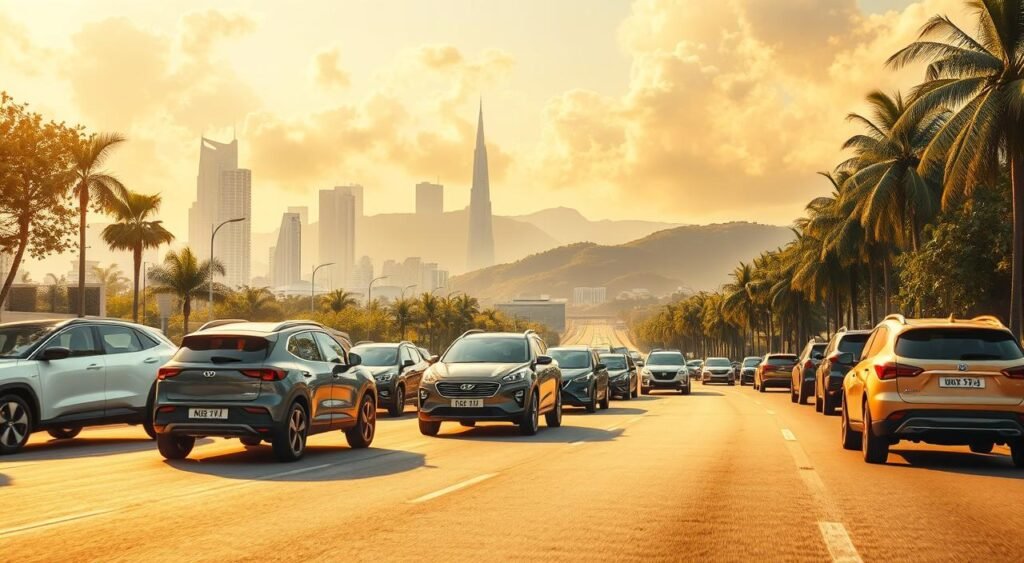
Trends in the Diesel SUV Market
The diesel SUV market in India has seen big changes. Emission norms have tightened, and there’s a push for greener cars. Despite this, car makers are working hard to create low emission vehicles that meet Indian needs.
The table below shows the market share of diesel SUVs in India over the past three years:
| Year | Market Share |
|---|---|
| 2020 | 35% |
| 2021 | 32% |
| 2022 | 28% |
Factors Affecting Fuel Efficiency
Several things affect a diesel SUV’s fuel efficiency in India. Engine size is important, with smaller engines usually better for mileage. The type of transmission also matters, as newer technologies like AMT and CVT can improve fuel use.
Driving conditions and habits also play a big role. Traffic, road quality, and how you drive can all impact fuel efficiency. By driving efficiently and keeping your car in good shape, you can get the most out of your diesel SUV and help the environment.
Key Features of the Most Fuel Efficient Diesel SUVs
Choosing the most fuel-efficient diesel SUVs in India means looking at a few key features. These cars have advanced engines, smart transmissions, and new ways to control emissions. All these help them use less fuel.
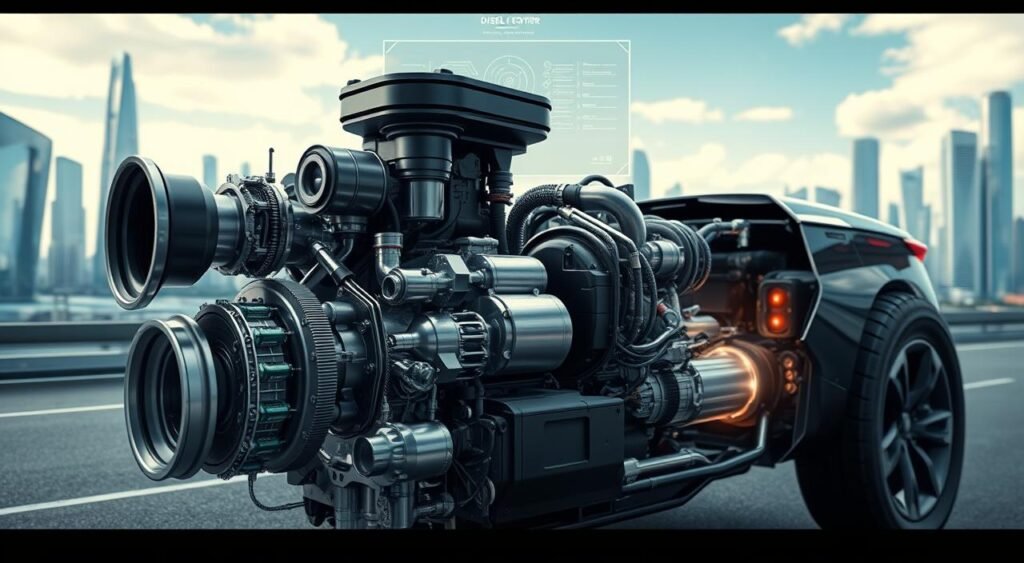
Engine Specifications
The engine is the heart of a fuel-efficient diesel SUV. Makers have worked on smaller engines that use less fuel but pack a punch. Engines range from 1.5 to 2.0 liters, with tech like fuel injection and turbocharging to boost efficiency.
Performance Metrics
These diesel SUVs are not just about saving fuel; they also perform well. They have strong torque for quick starts and towing. You can choose from 6-speed manual or automatic transmissions to get the best fuel use.
Technology and Innovations
Top tech is used in these diesel SUVs to save fuel. Start-stop systems turn off the engine when you’re stopped. They also use regenerative braking and aerodynamic designs to cut down on drag.
Also, they have advanced emission control systems. These include diesel particulate filters and selective catalytic reduction systems. They help meet strict pollution standards without losing performance or fuel efficiency.
Top 10 Most Fuel Efficient Diesel SUVs
Fuel efficiency is key when picking a diesel SUV in India. With fuel prices up and the environment in mind, a fuel-efficient car saves money and cuts down on pollution. Here, we explore the top 10 diesel SUVs in India for the best mileage.
Ranking Criteria
We looked at ARAI-certified mileage for each SUV. This gives a fair comparison. We also considered engine specs, transmission types, and performance for a full review of each vehicle.
Detailed Rankings from 10 to 1
Here’s the list of the top 10 fuel-efficient diesel SUVs in India, from 10 to 1:
- Mahindra XUV300 – 20.6 kmpl
- Renault Duster – 20.65 kmpl
- Nissan Kicks – 20.8 kmpl
- Maruti Suzuki Vitara Brezza – 21.1 kmpl
- Ford EcoSport – 21.7 kmpl
- Hyundai Creta – 21.8 kmpl
- Mahindra Bolero – 22.1 kmpl
- Tata Nexon – 24.08 kmpl
- Kia Sonet – 24.1 kmpl
- Hyundai Venue – 24.2 kmpl
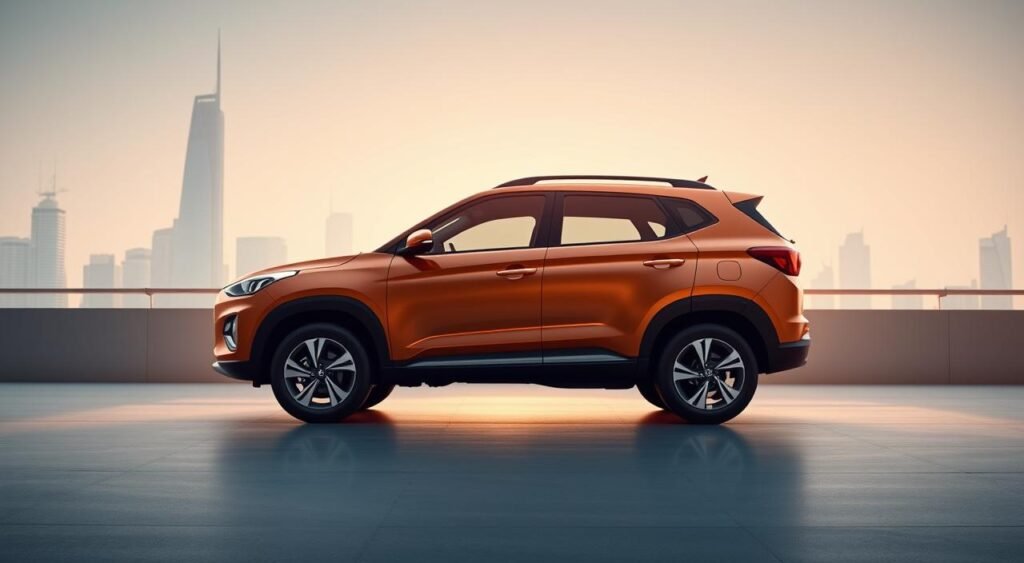
Key Highlights of Each SUV
Now, let’s look at what makes each SUV special:
- Hyundai Venue: The Venue has a 1.5-liter diesel engine and a 6-speed manual. It gets 24.2 kmpl.
- Kia Sonet: The Sonet has a 1.5-liter diesel engine. It’s available with manual or automatic, getting 24.1 kmpl.
- Tata Nexon: The Nexon’s 1.5-liter diesel engine works with manual or AMT. It gets 24.08 kmpl.
- Hyundai Creta: The Creta’s 1.5-liter diesel engine is offered with manual or automatic. It gets 21.8 kmpl.
- Mahindra XUV300: The XUV300’s 1.5-liter diesel engine and 6-speed manual get 20.6 kmpl.
These SUVs are great for their fuel efficiency, performance, and features. They’re favorites among Indian buyers.
Comparison of the Leading Diesel SUVs
Looking at the top diesel SUVs in India means more than just fuel efficiency. Price, value, maintenance costs, and customer satisfaction are key. These factors help decide the best SUV for you.

Price Range and Value for Money
Diesel SUVs in India vary in price, fitting different budgets. Some offer top features and tech, while others give great value. Think about what you need and can afford to find the best SUV.
Maintenance and Ownership Costs
Think about the cost of ownership when picking a diesel SUV. Maintenance, servicing, and spare parts costs add up. Look for good after-sales service and affordable maintenance for a smooth ownership.
Performance Ratings and User Reviews
Check out expert reviews and ratings for real-world mileage and performance. Look at handling, ride quality, and off-road skills. Also, read user reviews for customer satisfaction insights. Real experiences from owners can help you decide.
By looking at these points, you can pick the right diesel SUV. It should match your needs, budget, and hopes.
Conclusion and Recommendations
The Indian diesel SUV market has many fuel-efficient options. These vehicles meet different needs and budgets. This buyer’s guide highlights the top 10 most fuel-efficient diesel SUVs. They have impressive mileage, advanced engines, and innovative features for sustainable mobility.
When choosing a diesel SUV, consider fuel efficiency, performance, comfort, and cost. The Maruti Suzuki Vitara Brezza, Hyundai Creta, and Kia Seltos are great for those who want good mileage and value. For luxury, the BMW X3 and Mercedes-Benz GLC are top choices. They offer great fuel efficiency and premium features.
The future of diesel SUVs in India will be influenced by stricter environmental rules. Cleaner, more sustainable mobility solutions will become more common. Manufacturers will focus on advanced emission control, hybridization, and electrification to meet new norms.
Fuel efficiency is key for buyers with rising fuel prices and environmental concerns. By choosing wisely, buyers can find a diesel SUV that’s fuel-efficient and meets their needs. This choice helps make driving more sustainable and cost-effective.
FAQ
What are the benefits of choosing a diesel SUV in India?
Diesel SUVs are popular in India for their fuel efficiency and strong performance. They are great for long trips and off-road adventures. They also have a higher towing capacity than petrol SUVs.
What factors affect the fuel efficiency of diesel SUVs?
Several things can change how fuel-efficient a diesel SUV is. Engine size, transmission, and driving conditions matter. So does the use of emission control tech. Features like start-stop systems and regenerative braking can also help.
Which is the most fuel-efficient diesel SUV in India?
The Hyundai Venue is the most fuel-efficient diesel SUV in India, with 24.2 kmpl. The Kia Sonet and Tata Nexon are close behind, with 24.1 and 24.08 kmpl respectively.
What should I consider when choosing a fuel-efficient diesel SUV?
When picking a fuel-efficient diesel SUV, look at its mileage, engine, and transmission. Also, consider the price, value, maintenance costs, and what other users say. This helps you choose based on your needs and budget.
Are diesel SUVs more expensive to maintain than petrol SUVs?
Diesel SUVs might cost more to maintain than petrol ones. This is because diesel engines and their systems are more complex. But, their better fuel efficiency can save money over time, for those who drive a lot.
What is the future outlook for diesel SUVs in India?
The future of diesel SUVs in India is uncertain. Stricter emissions rules and a push for cleaner cars might reduce their number. But, makers are working on new tech to keep diesel SUVs up to date and green.
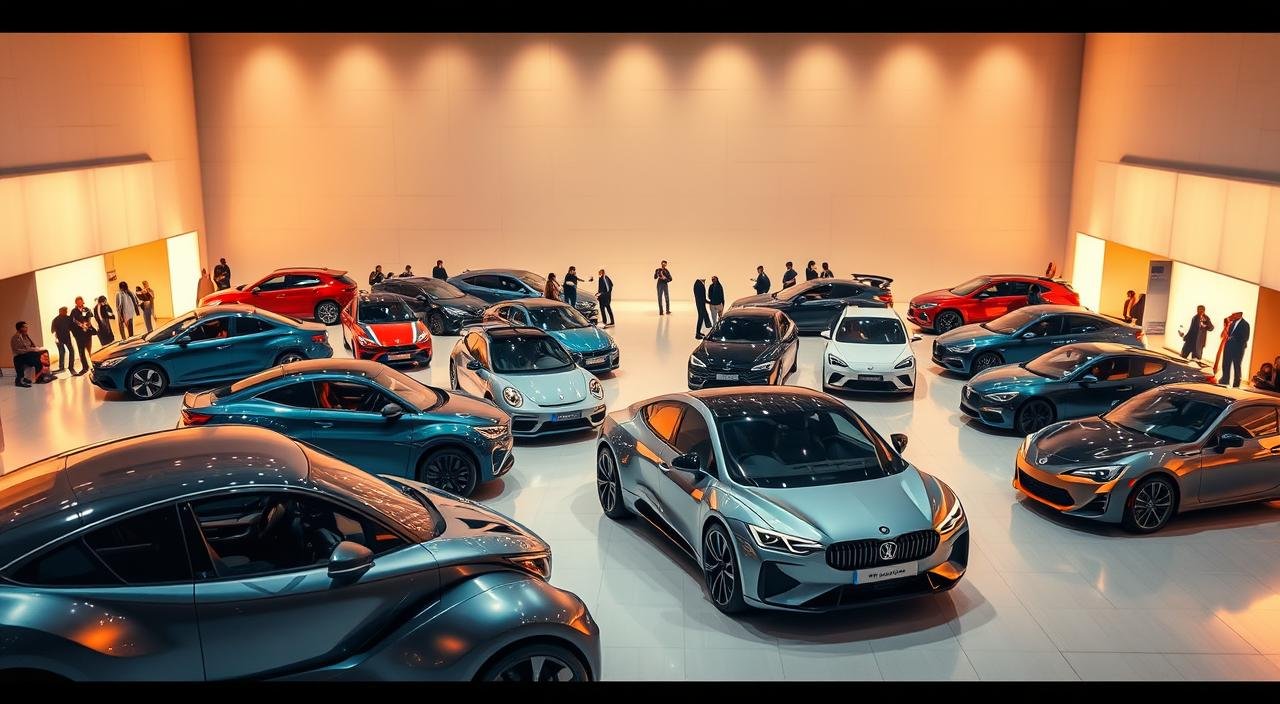
May
Get ready for a big change in India’s car market this April. Over 85 new models are coming, bringing lots of new things. You’ll see everything from cool hatchbacks to strong SUVs and green electric cars.
Car makers are working hard to bring you the best. They want to give you features, better performance, and great value. Whether you’re buying your first car or you love cars, there’s something for everyone.
Be amazed by the Kia Carens Clavis, a top SUV with luxury and safety. The Tata Altroz 2025 is a stylish hatchback that’s smart and fuel-efficient. And for thrill-seekers, the Volkswagen Golf GTI is coming to India, with its fast performance and cool looks.
Key Takeaways
- Over 85 new car models launching in India in April 2025
- Diverse range of options, from hatchbacks to SUVs and electric vehicles
- Models cater to various customer segments, with prices ranging from Rs. 7 lakh to Rs. 70 lakh
- Key launches include Kia Carens Clavis, Tata Altroz 2025, Volkswagen Golf GTI, and MG Cyberster
- Advanced features, enhanced performance, and eco-friendly options available
Overview of Car Launches in April 2025
The Indian car market is buzzing with new vehicle updates India in April 2025. Top car makers are introducing their latest car models India. This month, there’s something for every car lover, from sleek sedans to tough SUVs.
Key Highlights from This Month
April 2025 is a big deal for Indian cars. Several big launches are happening. Here are some highlights:
- Kia’s entry into the luxury sedan segment with the Kia Optima
- Tata Motors introducing the all-new Tata Safari, a feature-packed SUV
- Volkswagen launching the ID.4, its first all-electric SUV in India
- MG Motor unveiling the MG 6, a stylish and technologically advanced sedan
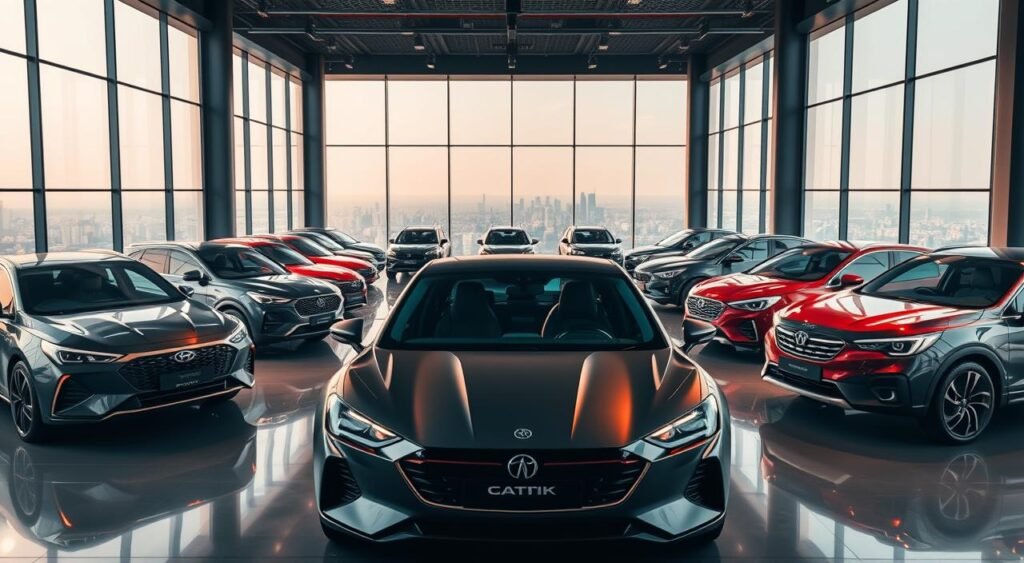
Manufacturer Participation
Major car makers are active in April 2025. Brands like Maruti Suzuki, Hyundai, Mahindra, and Toyota are launching new cars. They’re updating their models to keep up with the market.
Their new cars cover many types, like hatchbacks, sedans, SUVs, and electric vehicles. This meets the varied needs of Indian car buyers.
Market Trends and Expectations
The Indian car market is moving towards eco-friendly and tech-savvy vehicles. More people want electric and hybrid cars because of fuel costs and the environment. Car makers are adding more EVs and hybrids with better range and charging options.
SUVs and crossovers are also getting popular. Indian buyers want cars that are roomy, versatile, and can handle different terrains. Car makers are launching new SUVs with cool features and good prices.
April 2025 is just the start of an exciting year for cars. We can expect more vehicle updates India in the months to come.
SUVs Launched in India
The Indian car market saw a big jump in SUV launches in April 2025. This was to meet the growing need for versatile and roomy cars. SUVs are now more popular in India, and car makers have brought out new models with cool features and good prices.
Popular SUV Models Introduced
April 2025 brought some exciting SUVs to India. The Kia Carens Clavis, Tata Sierra, and Tata Harrier EV were among the top ones. These SUVs mix style, comfort, and power, pleasing many customers.
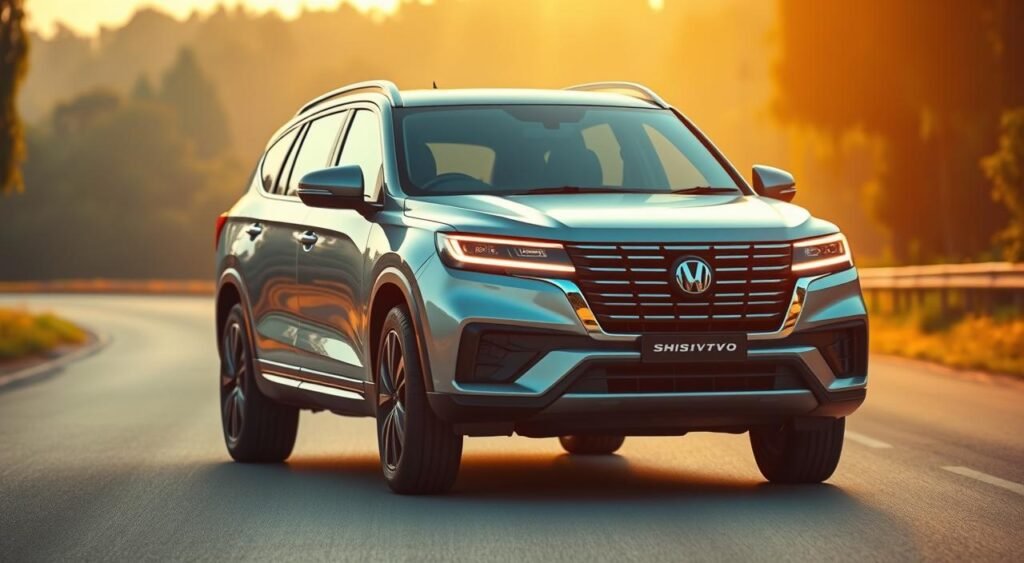
Comparison of Features and Pricing
The new SUVs have lots of features to make driving better. They have top-notch infotainment, big interiors, and strong engines. Prices range from Rs. 11 lakh to Rs. 28 lakh, fitting different budgets.
| SUV Model | Starting Price (Rs.) | Key Features |
|---|---|---|
| Kia Carens Clavis | 14 lakh | 10.25-inch touchscreen, ventilated seats, 360-degree camera |
| Tata Sierra | 16 lakh | Panoramic sunroof, wireless charging, connected car technology |
| Tata Harrier EV | 22 lakh | Electric powertrain, 400+ km range, fast charging capability |
Eco-friendly SUV Options
Car makers are focusing on green SUVs in India. The Tata Harrier EV and Maruti Suzuki e Vitara are great examples. They use electric or hybrid power, making them good for the planet and practical for daily use.
Compact Cars for Urban Mobility
In April 2025, the Indian car market saw the launch of exciting compact cars. These cars are perfect for city living, blending style, comfort, and tech. They meet the needs of today’s city folks.
Hatchbacks That Made Their Debut
This month, the Tata Altroz 2025 and the Volkswagen Golf GTI hit the market. The Tata Altroz 2025 has a sleek design and cool tech features. It’s great for those who love gadgets.
The Volkswagen Golf GTI, on the other hand, offers classic looks and strong performance. It’s perfect for those who love driving fast.
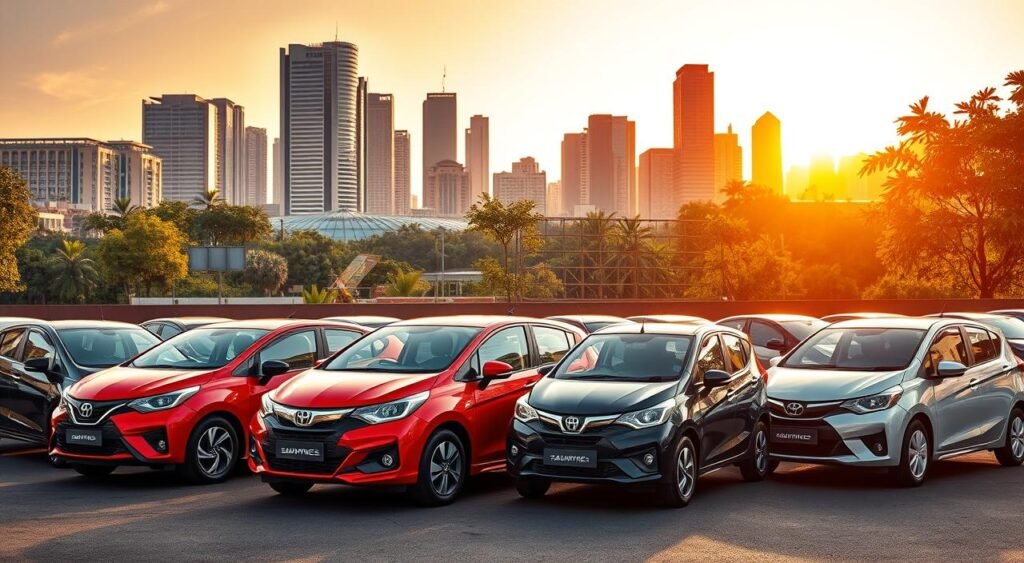
Technological Advancements in Compact Cars
The newest cars in India come with top-notch tech. They have safety features like lane warnings and automatic brakes. They also have cool infotainment systems that connect to your phone.
Here’s a comparison of the Tata Altroz 2025 and Volkswagen Golf GTI:
| Model | Engine | Power | Price (Ex-showroom) |
|---|---|---|---|
| Tata Altroz 2025 | 1.2L Turbo Petrol | 110 PS | Rs. 7.5 lakh – Rs. 11 lakh |
| Volkswagen Golf GTI | 2.0L TSI Petrol | 245 PS | Rs. 45 lakh – Rs. 50 lakh |
These cars are priced from Rs. 7 lakh to Rs. 50 lakh. They fit different budgets and tastes. As city driving changes, these cars will make driving better, combining style, tech, and power.
Luxury Vehicles Hit the Market
April 2025 is a big month for luxury car fans in India. Top brands are introducing their newest models. These cars come with the latest tech, stylish designs, and top-notch performance.
The Audi A6 2026 is getting a lot of attention, even though it’s not out yet. People can’t wait to see its cool features and design. It’s expected to take driving to a whole new level.
Premium Brands and Their New Offerings
Many famous luxury car makers are in the Indian market this month. Mercedes-Benz brings the AMG GT Coupe, a car that’s both powerful and stylish. BMW also joins with the 2 Series 2025, mixing sportiness with luxury.
Performance and Luxury Features
The new luxury cars have lots of fancy features. They have the latest tech for safety, comfort, and fun. These cars are packed with advanced systems.
These cars also have strong engines. You can choose from turbocharged, hybrid, or electric options. This meets different needs and cares for the environment.
Inside, these cars are all about luxury. They use top materials and have great craftsmanship. Leather, wood, and lights make the inside feel fancy and welcoming.
The prices of these cars range from Rs. 45 lakh to over Rs. 3 crore. This shows how special and high-end they are. With these new models, luxury car lovers in India have a lot to choose from.
Electric and Hybrid Vehicles Introduced
The Indian car market is moving towards green cars. In April 2025, many electric and hybrid cars will hit the roads. This shows the industry’s push to cut down on pollution and offer cleaner ways to travel.
Fast-Charging Models Available
The MG Cyberster is one of the top electric car launches in India this month. It’s an electric convertible that can charge up to 80% in 30 minutes. This makes long trips easier for EV owners.

These cars come with various features and prices. They meet the needs of different buyers.
Government Incentives for EV Buyers
The Indian government wants more people to buy electric and hybrid cars. They’ve set up hybrid vehicle incentives to help. These include:
| Incentive | Description |
|---|---|
| Tax Benefits | Lower GST rates and tax breaks for EV buyers |
| Subsidies | Direct subsidies based on battery size and car type |
| Infrastructure Support | Investments in charging stations and EV parking |
These government plans, along with more electric and hybrid cars, will boost green driving in India. This is expected to happen in the next few years.
Updates on Existing Models
The car industry in India is always changing. In April 2025, many popular cars will get facelifts and new variants. This shows how brands keep up with customer needs.
Some big updates include the Maruti Brezza, Hyundai Tucson, and Tata Punch. These cars will have new looks, better performance, and more features. They aim to please Indian car buyers.

Facelifts and New Variants
The vehicle facelifts in 2025 will make old cars look new again. Maruti Suzuki is updating its Brezza compact SUV. It will have a fresh design and more features.
Hyundai is also refreshing its Tucson SUV. It will have a bold new look, better interior, and new tech.
Customer Feedback and Improvements
Car makers listen to what customers say when updating their models. Tata Motors is updating its Punch micro-SUV based on customer feedback.
By listening to customers, car makers show they care. These updates make driving better and keep cars competitive in a fast-changing market.
Conclusion: The Future of Indian Automotive Market
The car launches in India in April 2025 show the market’s fast pace. Companies have brought out a wide range of cars. This includes SUVs, compact cars, luxury models, and eco-friendly options.
These new cars aim to meet the changing needs of Indian buyers. They highlight the industry’s focus on innovation, green tech, and making customers happy.
Summarizing Key Launches
In April 2025, many exciting models hit the market. SUVs were a big hit, with lots of features and good prices. Compact cars also made a splash, with cool tech and solutions for city driving.
Luxury brands unveiled new cars with top-notch features and better performance. Electric and hybrid cars also got more attention. This is thanks to government help and people wanting greener transport.
Predictions for Upcoming Months
The Indian car market is set to keep growing and changing. Electric cars will likely become more popular, with more affordable and longer-range options. We’ll see more cars that connect to the internet, making driving safer and more personal.
There will also be a push for cars that use less fuel and produce fewer emissions. The Indian car industry is ready for big changes. This is thanks to new tech, what people want, and government support.
FAQ
What are the most notable car launches in India for April 2025?
April 2025 brings exciting new cars to India. The Kia Carens Clavis, Tata Altroz 2025, Volkswagen Golf GTI, and MG Cyberster are among them. These cars offer great features for different needs.
How many new car models are expected to be launched in India during April 2025?
Over 85 new car models will hit the Indian market in April 2025. This shows the growth and change in the auto industry.
What is the price range for the new cars launched in April 2025?
The new cars in April 2025 fit various budgets. Prices start at Rs. 7 lakh for small cars and go over Rs. 3 crore for luxury ones.
Which car segments are dominating the April 2025 launches in India?
SUVs lead the market in April 2025 with models like the Kia Carens Clavis and Tata Harrier EV. Compact cars and hatchbacks are also popular for city driving.
Are there any eco-friendly car options being launched in April 2025?
Yes, April 2025 sees the debut of electric and hybrid cars. The MG Cyberster and Tata Harrier EV are among them. These cars show India’s shift towards green mobility.
What are some of the advanced features offered in the new car models?
The newest cars feature advanced tech. They have top-notch infotainment, connected car tech, ADAS, and efficient engines. These features improve driving and safety.
Are there any updates or facelifts for existing car models in April 2025?
Yes, models like the Maruti Brezza and Hyundai Tucson get updates in April 2025. These updates aim to make these cars more appealing and competitive.
What incentives are available for buyers of electric vehicles in India?
The Indian government offers incentives for electric vehicle buyers. These include tax breaks, subsidies, and support for charging infrastructure. This makes EVs more appealing for those who care about the environment.

Apr
Are you looking for the safest subcompact SUVs in India? It’s important to know which models pass the tough crash tests by Bharat NCAP. We explore the top-rated subcompact SUVs with a 5-star safety rating. This ensures your safety and that of your loved ones on the road.
Sub-4m SUVs are becoming more popular, and car makers are focusing on safety. Bharat NCAP tests these models under Rs 10 lakh. We’ve made a detailed list of the safest subcompact SUVs with a 5-star safety rating.
Get ready to see the safest SUVs in India. We’ll show you the Bharat NCAP rated SUVs that lead in safety. These SUVs have advanced safety features and strong body structures. They offer peace of mind and an exciting drive.
Key Takeaways
- Discover the safest subcompact SUVs in India with 5-star Bharat NCAP ratings
- Learn about the importance of safety ratings in SUV selection
- Explore the key safety features and crash test results of top-rated models
- Understand how Bharat NCAP evaluates vehicle safety
- Make an informed decision when choosing your next subcompact SUV
What is Bharat NCAP and Why It Matters?
The Bharat New Car Assessment Programme (BNCAP) is a key effort by the Indian government to boost car safety. It started in 2023, taking over from Global NCAP. BNCAP tests cars sold in India and gives safety ratings based on how they do in these tests.
BNCAP’s main goal is to help people know about a car’s safety before buying it. It wants to make sure cars are safer for everyone. This way, BNCAP encourages car makers to focus on making safer cars for India.
Understanding NCAP Ratings
NCAP ratings come from crash tests that check how well a car protects people in crashes. These tests look at things like how strong the car is, its safety features, and how well it holds people in place. Ratings go from 0 to 5 stars, with 5 stars being the safest.
Importance of Safety Ratings in SUVs
Safety ratings are very important when picking a subcompact SUV. These cars are often chosen by families and others who want safety and value. Looking at BNCAP ratings helps buyers find SUVs that are safer in crashes, keeping everyone safe and giving peace of mind.
As India’s car market grows, BNCAP is key in making cars safer. It helps people make smart choices by setting high safety standards and being open about car safety. This makes the car industry in India safer and more responsible.
The Subcompact SUV Segment Defined
Subcompact SUVs, also known as Indian subcompact SUVs or sub-4m SUVs, have found a special place in the Indian car market. They mix SUV looks, affordability, and easy handling. This makes them a favorite among many Indian buyers.
Characteristics of Subcompact SUVs
These cars are small, usually under 4 meters long. This size helps them move through crowded city streets easily. They also have enough room inside for people and stuff. Some key features include:
- Raised ground clearance for better road presence and mild off-road capability
- Fuel-efficient engines, often under 1.5 liters in displacement
- Spacious interiors with flexible seating configurations
- Advanced safety features, including multiple airbags and electronic stability control
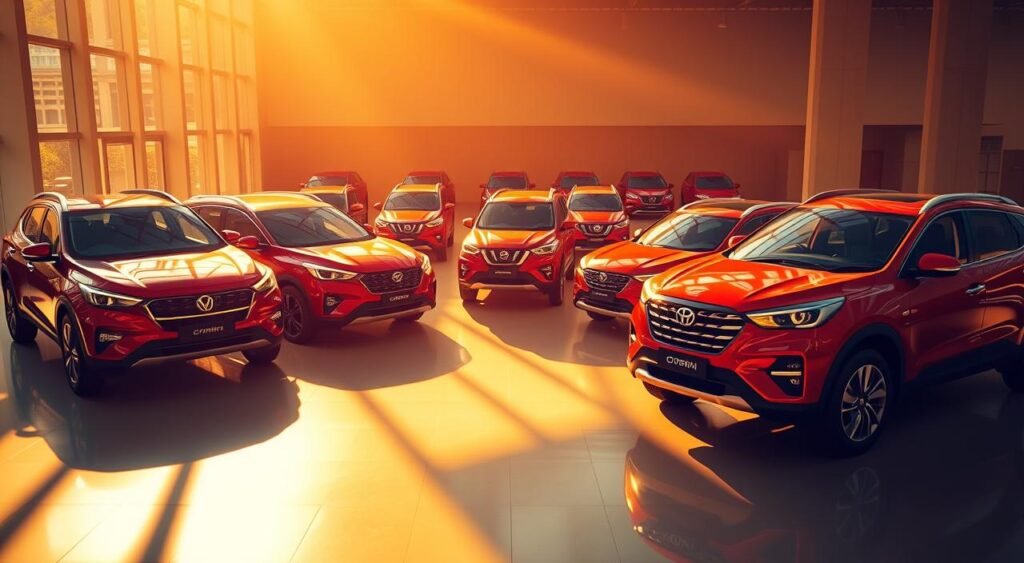
Popularity of Subcompact SUVs in India
Several reasons explain why sub-4m SUVs are popular in India. They offer the look of an SUV at a lower price than bigger models. Their small size is perfect for India’s busy streets and tight parking spots.
The table below shows the sales of some top subcompact SUVs in India for 2022-2023:
| Model | Sales (FY 2022-23) |
|---|---|
| Tata Nexon | 175,668 |
| Maruti Suzuki Vitara Brezza | 148,190 |
| Hyundai Venue | 114,870 |
| Kia Sonet | 101,778 |
These numbers show subcompact SUVs are very popular in India. Many models are among the top-selling cars in the country.
Notable 5-Star Bharat NCAP Rated Subcompact SUVs
Safety is key for Indian car buyers, and many subcompact SUVs have stepped up. They’ve earned 5-star ratings from Bharat NCAP. These cars are stylish, versatile, and put passenger safety first.
Bharat NCAP tests vehicles to see how well they protect people in crashes. The top-rated subcompact SUVs get 5 stars in adult and child safety tests.
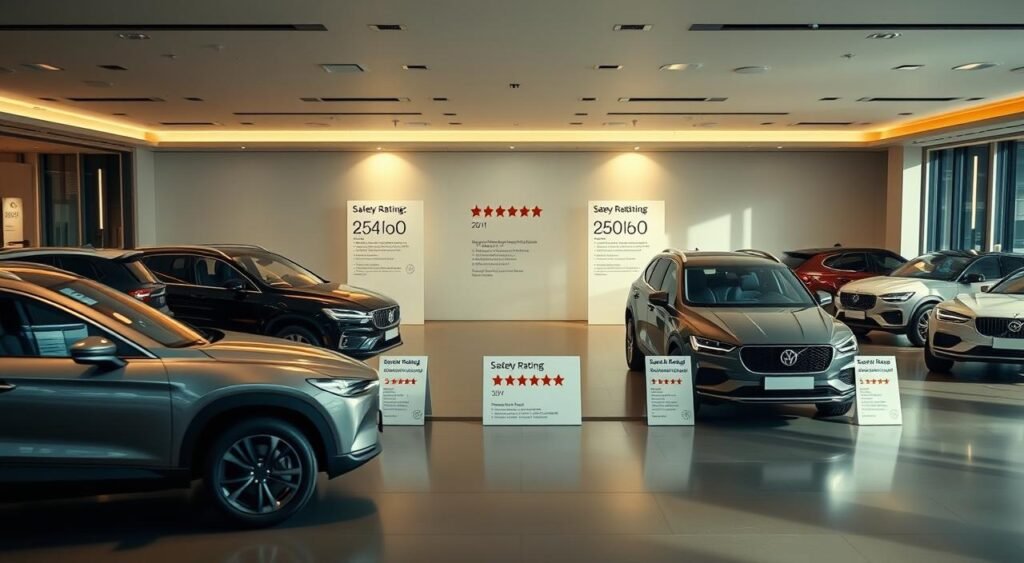
Complete List of 5-Star Rated Models
By April 2025, some subcompact SUVs have reached the top with 5-star ratings from Bharat NCAP:
- Tata Nexon
- Mahindra XUV 3XO
- Tata Punch EV
- Mahindra XUV400 EV
- Tata Nexon EV
- Tata Curvv
- Tata Curvv EV
These SUVs are the safest in their class. They have the latest safety features and strong build. Driving one of these 5-star SUVs means you’re in a very safe car.
Mahindra XUV 3XO: A Look at Its Safety Features
The Mahindra XUV 3XO is a top choice for safety, earning a 5-star crash test rating from Bharat NCAP. It’s a subcompact SUV that excels in protecting both adults and children. This is thanks to its wide range of safety features.
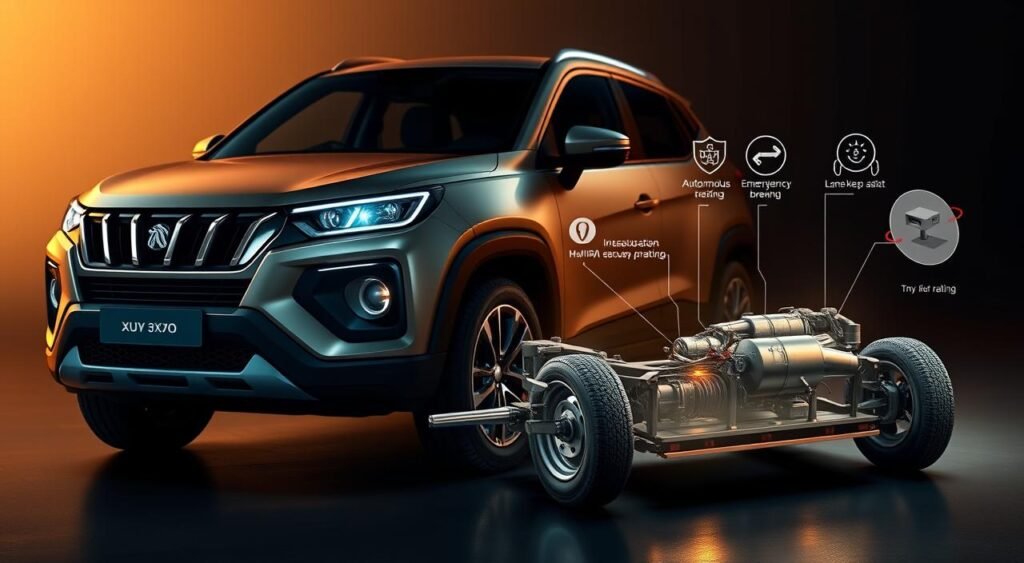
In crash tests, the XUV 3XO scored high. It got 29.36 out of 32 points for adult safety and 43 out of 49 for child safety. Its strong body and advanced safety tech were key to these great scores.
Advanced Driver Assistance Systems
The Mahindra XUV 3XO comes with advanced safety systems. These systems make driving safer and more confident. The features include:
- 360-degree camera system for better visibility
- Hill hold and descent control for safe driving on hills
- Automatic emergency braking to avoid crashes
- Lane departure warning to keep the vehicle on track
Impact Test Results
In the frontal offset test, the XUV 3XO scored 13.36 out of 16 points. This shows it’s good at protecting people in head-on crashes. The side movable deformable barrier test also showed its safety, with a perfect score of 16 out of 16 points.
Other key safety features of the Mahindra XUV 3XO include:
- 6 airbags for full occupant protection
- 3-point seatbelts for all passengers
- All-wheel disc brakes for better stopping power
- ISOFIX child seat anchors for secure child safety
The Mahindra XUV 3XO is a leader in safety, thanks to its crash test results and safety features. It’s a 5-star rated vehicle that’s perfect for those who value safety. It’s a top choice in the subcompact SUV market.
Tata Nexon: Safety Innovations and Ratings
The Tata Nexon has raised the bar for safety in the subcompact SUV market. It boasts impressive crash test ratings and cutting-edge safety features. This has caught the eye of both experts and customers.
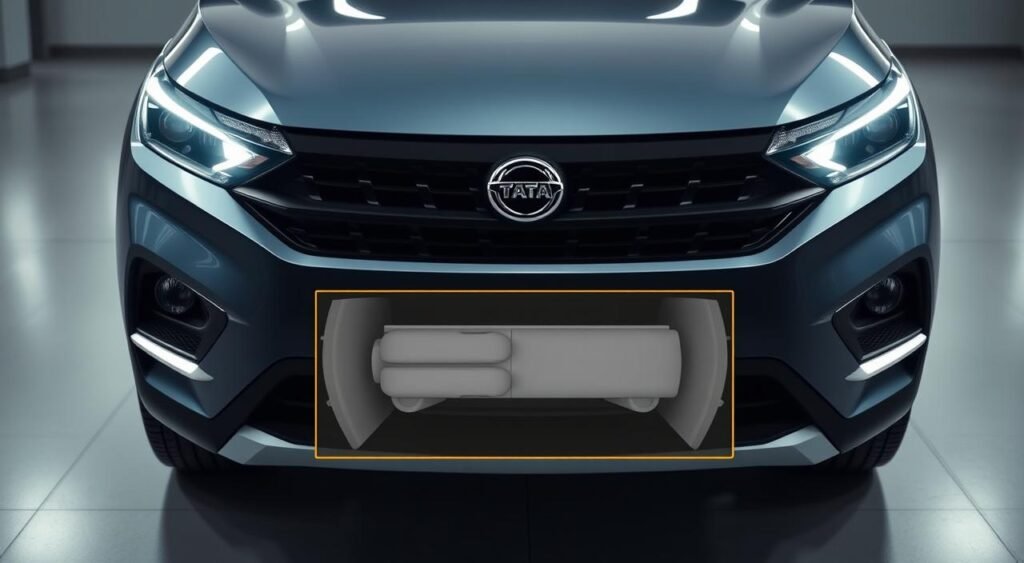
In Bharat NCAP crash tests, the Tata Nexon earned a 5-star safety rating. It scored well in adult and child occupant protection. The Nexon’s strong build and advanced safety systems are highlighted by these ratings.
Key Safety Features
The Tata Nexon is packed with safety features to protect occupants in crashes. Some standout features include:
- 6 airbags as standard, providing all-around protection
- Electronic Stability Control (ESC) for enhanced vehicle stability
- Anti-lock Braking System (ABS) with Electronic Brake-force Distribution (EBD)
- ISOFIX child seat mounts for secure child seat installation
- 360-degree camera system with parking sensors for improved visibility
Customer Feedback on Safety
Customers love the Tata Nexon for its top-notch safety. They feel confident it keeps their family safe. The Nexon’s strong performance in Nexon crash test ratings solidifies its status as a safe, reliable SUV.
Tata Punch EV: Raising the Bar for Safety
The Tata Punch EV is a top pick among 5-star rated subcompact SUVs in India. It shines with its safety features and high crash test scores. This electric version of the Tata Punch is not just eco-friendly but also puts safety first.
Comprehensive Safety Package
Tata has packed the Punch EV with a wide range of safety features. It comes with six airbags for protection of both front and rear passengers. It also has a 360-degree camera system for better visibility and easier parking.
Other key safety features include an electronic stability control (ESC) system and an electronic parking brake. It also has a blind spot view monitor, hill hold control, and hill descent control. These features ensure the vehicle stays stable and controlled, giving drivers and passengers peace of mind.

Impressive Crash Test Scores
The Tata Punch EV has aced crash tests by Bharat NCAP. It scored an outstanding 31.46 out of 32 points in adult occupant protection. This shows the vehicle’s strong structure and advanced safety systems for adult passengers.
In child occupant protection tests, the Punch EV scored 45 out of 49 points. This highlights Tata’s dedication to keeping young passengers safe. It has ISOFIX child seat anchors and well-designed rear seats.
The Tata Punch EV’s safety ratings show Tata’s strong commitment to safety. By focusing on safety and eco-friendliness, Tata has set a new standard in the subcompact SUV market. This makes the Punch EV a great choice for those who value safety.
Mahindra XUV400 EV: Electrifying Performance, Uncompromised Safety
The Mahindra XUV400 EV is a game-changer in the subcompact SUV segment. It combines impressive electric performance with top-notch safety features. This stylish and eco-friendly SUV has been meticulously designed to prioritize the well-being of its occupants. It has earned a coveted 5-star safety rating from Bharat NCAP.
The vehicle boasts an extensive array of safety equipment. This ensures a secure and confident driving experience. From multiple airbags to advanced driver assistance systems, the XUV400 EV leaves no stone unturned when it comes to protecting its passengers.
Extensive Safety Equipment
The Mahindra XUV400 EV is equipped with a safety package that includes:
- Up to six airbags for all-around protection
- Electronic Stability Program (ESP) for enhanced vehicle control
- Tyre Pressure Monitoring System (TPMS) to ensure optimal tyre performance
- Hill Hold Assist for easy and safe starts on inclines
- Rear parking camera for improved visibility while reversing
Bharat NCAP Ratings
The XUV400 EV’s commitment to safety is evident in its impressive crash test scores. In the rigorous Bharat NCAP tests, the vehicle achieved a perfect 5-star rating. This showcases its exceptional safety performance.
The XUV400 EV scored an impressive 30.38 out of 32 points in adult occupant protection. It also scored 43 out of 49 points in child occupant protection.
| Bharat NCAP Category | Score | Max Points |
|---|---|---|
| Adult Occupant Protection | 30.38 | 32 |
| Child Occupant Protection | 43 | 49 |
These outstanding crash test scores demonstrate Mahindra’s unwavering dedication to passenger safety. They set a new benchmark for safety standards in the subcompact SUV segment.
Tata Nexon EV: Combining Eco-Friendliness with Safety
The Tata Nexon EV is a green choice for a subcompact SUV. It also focuses on keeping passengers safe. It got a 5-star safety rating from Bharat NCAP, showing Tata’s dedication to safety.
In the Nexon EV crash test, it scored well. It got 29.86 out of 32 points for adult safety and 44.95 out of 49 for child safety. These scores are just a bit higher than its gas-powered version, proving electric doesn’t mean less safety.
Comprehensive Safety Features
The Tata Nexon EV has many safety features. These include:
- Six airbags placed all over the cabin
- Electronic Stability Control (ESC) for better handling
- Front and rear parking sensors for easier parking
- ISOFIX child-seat mounts for safe child seats
- Hill hold control and hill descent control for steep roads
- Electronic parking brake with auto hold for easy parking
Setting the Standard for Electric Vehicle Safety
The Nexon EV shines in Bharat NCAP crash tests. It has a long list of Tata Nexon EV safety features. This makes it a top choice for safe, eco-friendly driving in India.
Future of Safety Ratings in the Indian Market
The Indian car industry is growing fast, and safety is now a big deal. The Bharat New Car Assessment Program (NCAP) has changed how we check car safety. This change will lead to big updates in Indian automotive safety trends and vehicle safety regulations.
Advanced Driver Assistance Systems (ADAS) are becoming more common. These include features like lane departure warnings and automatic emergency braking. As more people learn about these, car makers will add them to more cars.
Strengthening Vehicle Safety Regulations
The Indian government is also playing a big part in making cars safer. They plan to make vehicle safety regulations stricter and crash testing mandatory. This will make sure all cars sold meet safety standards. It will also push car makers to focus more on safety.
Impact of Bharat NCAP Ratings
Bharat NCAP ratings will be very important when buying a car. As more cars get tested and get safety scores, buyers will know more about the safety of their car. This will make car makers compete to make safer cars for everyone.
| Safety Trend | Impact on Indian Automotive Industry |
|---|---|
| Increased adoption of ADAS | Reduced accidents, improved driver assistance |
| Stricter vehicle safety regulations | Higher safety standards, better consumer protection |
| Importance of Bharat NCAP ratings | Transparent safety information, increased competition |
As Indian automotive safety trends keep changing, we’re heading towards a safer car future. With new tech, stricter rules, and Bharat NCAP ratings, the Indian car market will keep getting better. This means safer driving for everyone.
Conclusion: Making Informed Decisions for Safety
When looking for the safest subcompact SUVs in India, focus on vehicle safety ratings. Bharat NCAP ratings show how safe a car is in crashes. A 5-star rated safe SUV means your car can protect you and your family in accidents.
Importance of Considering Safety in SUV Choice
Subcompact SUVs are getting more popular in India. But, don’t just look at style and features. Safety is key. Tata and Mahindra show they care about safety with their 5-star rated models.
Final Thoughts on the 5-Star Rated SUVs
The Tata Nexon, Mahindra XUV 3XO, Tata Punch EV, Mahindra XUV400 EV, and Tata Nexon EV are top picks for safety. They offer safety without losing out on features or performance. These SUVs set a high standard for the market. As safety rules get better and car tech advances, we’ll see more 5-star SUVs. This means more safe options for Indian buyers.
FAQ
What is Bharat NCAP and why is it important?
Bharat New Car Assessment Programme (BNCAP) is a government program. It tests cars for safety and gives them safety scores. This helps buyers choose safer cars.
What are the characteristics of subcompact SUVs?
Subcompact SUVs are small, affordable, and look like SUVs. They have enough room, high ground clearance, and are easy to drive on Indian roads.
Which subcompact SUVs have achieved 5-star ratings in Bharat NCAP?
By April 2025, seven subcompact SUVs got 5-star ratings from Bharat NCAP. These include the Tata Nexon, Mahindra XUV 3XO, Tata Punch EV, Mahindra XUV400 EV, Tata Nexon EV, Tata Curvv, and Tata Curvv EV.
What safety features does the Mahindra XUV 3XO offer?
The Mahindra XUV 3XO has 6 airbags and a 360-degree camera. It also has hill hold and descent control, 3-point seatbelts, all-wheel disc brakes, and level-2 ADAS.
How did the Tata Nexon perform in Bharat NCAP crash tests?
The Tata Nexon got a 5-star safety rating. It scored 29.41/32 for adult protection and 43.83/49 for child protection. It also did well in frontal and side tests.
What makes the Tata Punch EV stand out in terms of safety?
The Tata Punch EV has the highest safety scores among 5-star cars. It scored 31.46/32 for adult protection and 45/49 for child protection. It comes with many safety features as standard.
What are the anticipated trends in vehicle safety in the Indian market?
Bharat NCAP is making Indian cars safer. Manufacturers are focusing on safety and crash tests. Expect more ADAS features and stricter safety rules soon.
What should buyers consider when choosing a subcompact SUV in India?
Safety is key when picking a subcompact SUV in India. Look for 5-star Bharat NCAP models like the Tata Nexon, Mahindra XUV 3XO, Tata Punch EV, Mahindra XUV400 EV, and Tata Nexon EV. Think about your needs and preferences too.
